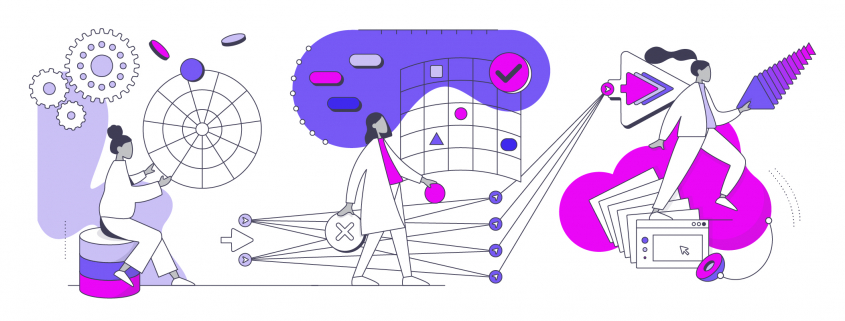Tag Archive for: Deep Learning
Data-driven Attribution Modeling
/in Artificial Intelligence, Business Analytics, Business Intelligence, Data Science, Deep Learning, Machine Learning, Main Category, Use Cases/by Alexander LammersIn the world of commerce, companies often face the temptation to reduce their marketing spending, especially during times of economic uncertainty or when planning to cut costs. However, this short-term strategy can lead to long-term consequences that may hinder a company’s growth and competitiveness in the market.
Maintaining a consistent marketing presence is crucial for businesses, as it helps to keep the company at the forefront of their target audience’s minds. By reducing marketing efforts, companies risk losing visibility and brand awareness among potential clients, which can be difficult and expensive to regain later. Moreover, a strong marketing strategy is essential for building trust and credibility with prospective customers, as it demonstrates the company’s expertise, values, and commitment to their industry.
Given a fixed budget, companies apply economic principles for marketing efforts and need to spend a given marketing budget as efficient as possible. In this view, attribution models are an essential tool for companies to understand the effectiveness of their marketing efforts and optimize their strategies for maximum return on investments (ROI). By assigning optimal credit to various touchpoints in the customer journey, these models provide valuable insights into which channels, campaigns, and interactions have the greatest impact on driving conversions and therefore revenue. Identifying the most important channels enables companies to distribute the given budget accordingly in an optimal way.
1. Combining business value with attribution modeling
The true value of attribution modeling lies not solely in applying the optimal theoretical concept – that are discussed below – but in the practical application in coherence with the business logic of the firm. Therefore, the correct modeling ensures that companies are not only distributing their budget in an optimal way but also that they incorporate the business logic to focus on an optimal long-term growth strategy.
Understanding and incorporating business logic into attribution models is the critical step that is often overlooked or poorly understood. However, it is the key to unlocking the full potential of attribution modeling and making data-driven decisions that align with business goals. Without properly integrating the business logic, even the most sophisticated attribution models will fail to provide actionable insights and may lead to misguided marketing strategies.
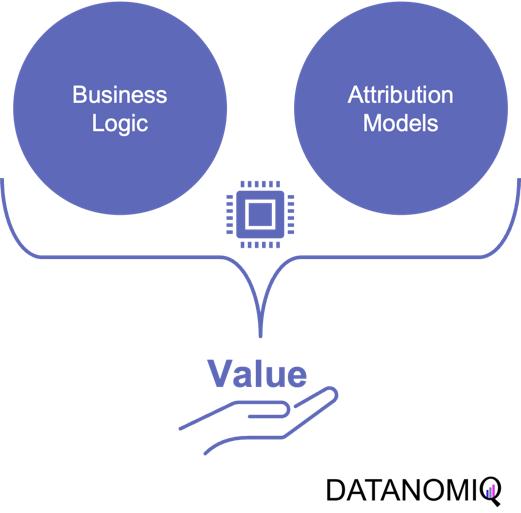
Figure 1 – Combining the business logic with attribution modeling to generate value for firms
For example, determining the end of a customer journey is a critical step in attribution modeling. When there are long gaps between customer interactions and touchpoints, analysts must carefully examine the data to decide if the current journey has concluded or is still ongoing. To make this determination, they need to consider the length of the gap in relation to typical journey durations and assess whether the gap follows a common sequence of touchpoints. By analyzing this data in an appropriate way, businesses can more accurately assess the impact of their marketing efforts and avoid attributing credit to touchpoints that are no longer relevant.
Another important consideration is accounting for conversions that ultimately lead to returns or cancellations. While it’s easy to get excited about the number of conversions generated by marketing campaigns, it’s essential to recognize that not all conversions should be valued equal. If a significant portion of conversions result in returns or cancellations, the true value of those campaigns may be much lower than initially believed.
To effectively incorporate these factors into attribution models, businesses need to important things. First, a robust data platform (such as a customer data platform; CDP) that can integrate data from various sources, such as tracking systems, ERP systems, e-commerce platforms to effectively perform data analytics. This allows for a holistic view of the customer journey, including post-conversion events like returns and cancellations, which are crucial for accurate attribution modeling. Second, as outlined above, businesses need a profound understanding of the business model and logic.
2. On the Relevance of Attribution Models in Online Marketing
A conversion is a point in the customer journey where a recipient of a marketing message performs a somewhat desired action. For example, open an email, click on a call-to-action link or go to a landing page and fill out a registration. Finally, the ultimate conversion would be of course buying the product. Attribution models serve as frameworks that help marketers assess the business impact of different channels on a customer’s decision to convert along a customer´s journey. By providing insights into which interactions most effectively drive sales, these models enable more efficient resource allocation given a fixed budget.

Figure 2 – A simple illustration of one single customer journey. Consider that from the company’s perspective all journeys together result into a complex network of possible journey steps.
Companies typically utilize a diverse marketing mix, including email marketing, search engine advertising (SEA), search engine optimization (SEO), affiliate marketing, and social media. Attribution models facilitate the analysis of customer interactions across these touchpoints, offering a comprehensive view of the customer journey.
-
Comprehensive Customer Insights: By identifying the most effective channels for driving conversions, attribution models allow marketers to tailor strategies that enhance customer engagement and improve conversion rates.
-
Optimized Budget Allocation: These models reveal the performance of various marketing channels, helping marketers allocate budgets more efficiently. This ensures that resources are directed towards channels that offer the highest return on investment (ROI), maximizing marketing impact.
-
Data-Driven Decision Making: Attribution models empower marketers to make informed, data-driven decisions, leading to more effective campaign strategies and better alignment between marketing and sales efforts.
In the realm of online advertising, evaluating media effectiveness is a critical component of the decision-making process. Since advertisement costs often depend on clicks or impressions, understanding each channel’s effectiveness is vital. A multi-channel attribution model is necessary to grasp the marketing impact of each channel and the overall effectiveness of online marketing activities. This approach ensures optimal budget allocation, enhances ROI, and drives successful marketing outcomes.
What types of attribution models are there? Depending on the attribution model, different values are assigned to various touchpoints. These models help determine which channels are the most important and should be prioritized. Each channel is assigned a monetary value based on its contribution to success. This weighting then determines the allocation of the marketing budget. Below are some attribution models commonly used in marketing practice.
2.1. Single-Touch Attribution Models
As it follows from the name of the group of these approaches, they consider only one touchpoint.
2.1.1 First Touch Attribution
First touch attribution is the standard and simplest method for attributing conversions, as it assigns full credit to the first interaction. One of its main advantages is its simplicity; it is a straightforward and easy-to-understand approach. Additionally, it allows for quick implementation without the need for complex calculations or data analysis, making it a convenient choice for organizations looking for a simple attribution method. This model can be particularly beneficial when the focus is solely on demand generation. However, there are notable drawbacks to first touch attribution. It tends to oversimplify the customer journey by ignoring the influence of subsequent touchpoints. This can lead to a limited view of channel performance, as it may disproportionately credit channels that are more likely to be the first point of contact, potentially overlooking the contributions of other channels that assist in conversions.
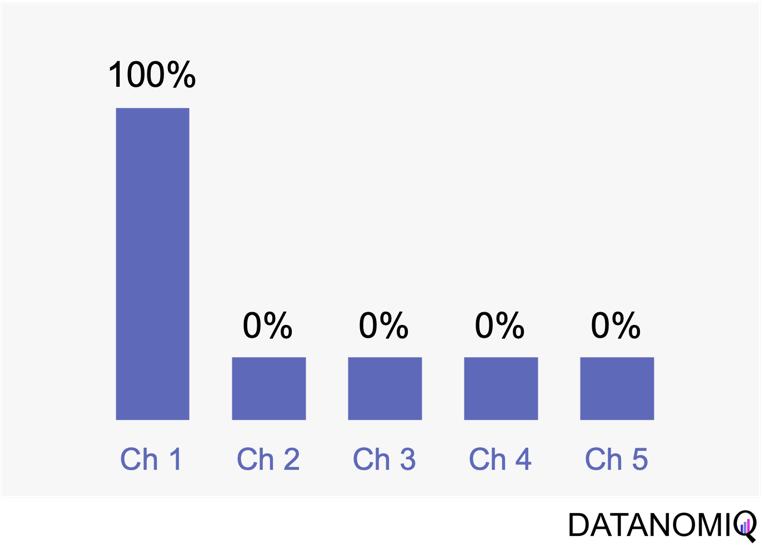
Figure 3 – The first touch is a simple non-intelligent way of attribution.
2.1.2 Last Touch Attribution
Last touch attribution is another straightforward method for attributing conversions, serving as the opposite of first touch attribution by assigning full credit to the last interaction. Its simplicity is one of its main advantages, as it is easy to understand and implement without the need for complex calculations or data analysis. This makes it a convenient choice for organizations seeking a simple attribution approach, especially when the focus is solely on driving conversions. However, last touch attribution also has its drawbacks. It tends to oversimplify the customer journey by neglecting the influence of earlier touchpoints. This approach provides limited insights into the full customer journey, as it focuses solely on the last touchpoint and overlooks the cumulative impact of multiple touchpoints, missing out on valuable insights.
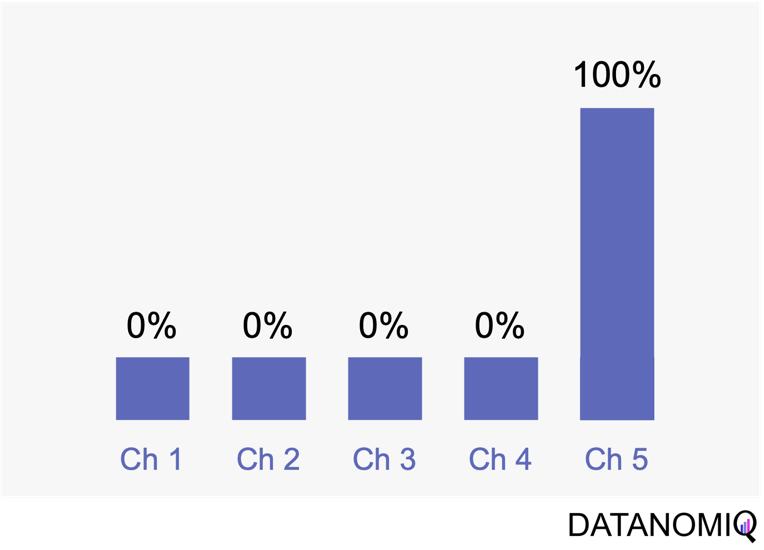
Figure 4 – Last touch attribution is the counterpart to the first touch approach.
2.2 Multi-Touch Attribution Models
We noted that single-touch attribution models are easy to interpret and implement. However, these methods often fall short in assigning credit, as they apply rules arbitrarily and fail to accurately gauge the contribution of each touchpoint in the consumer journey. As a result, marketers may make decisions based on skewed data. In contrast, multi-touch attribution leverages individual user-level data from various channels. It calculates and assigns credit to the marketing touchpoints that have influenced a desired business outcome for a specific key performance indicator (KPI) event.
2.2.1 Linear Attribution
Linear attribution is a standard approach that improves upon single-touch models by considering all interactions and assigning them equal weight. For instance, if there are five touchpoints in a customer’s journey, each would receive 20% of the credit for the conversion. This method offers several advantages. Firstly, it ensures equal distribution of credit across all touchpoints, providing a balanced representation of each touchpoint’s contribution to conversions. This approach promotes fairness by avoiding the overemphasis or neglect of specific touchpoints, ensuring that credit is distributed evenly among channels. Additionally, linear attribution is easy to implement, requiring no complex calculations or data analysis, which makes it a convenient choice for organizations seeking a straightforward attribution method. However, linear attribution also has its drawbacks. One significant limitation is its lack of differentiation, as it assigns equal credit to each touchpoint regardless of their actual impact on driving conversions. This can lead to an inaccurate representation of the effectiveness of individual touchpoints. Furthermore, linear attribution ignores the concept of time decay, meaning it does not account for the diminishing influence of earlier touchpoints over time. It treats all touchpoints equally, regardless of their temporal proximity to the conversion event, potentially overlooking the greater impact of more recent interactions.
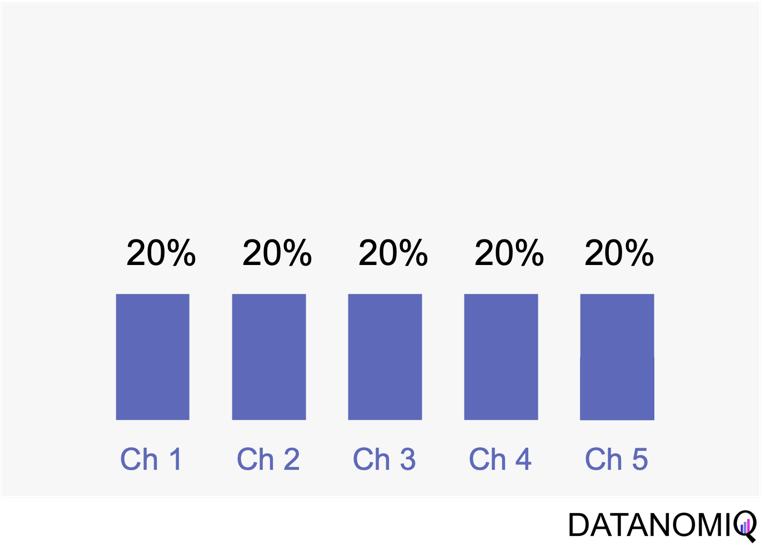
Figure 5 – Linear uniform attribution.
2.2.2 Position-based Attribution (U-Shaped Attribution & W-Shaped Attribution)
Position-based attribution, encompassing both U-shaped and W-shaped models, focuses on assigning the most significant weight to the first and last touchpoints in a customer’s journey. In the W-shaped attribution model, the middle touchpoint also receives a substantial amount of credit. This approach offers several advantages. One of the primary benefits is the weighted credit system, which assigns more credit to key touchpoints such as the first and last interactions, and sometimes additional key touchpoints in between. This allows marketers to highlight the importance of these critical interactions in driving conversions. Additionally, position-based attribution provides flexibility, enabling businesses to customize and adjust the distribution of credit according to their specific objectives and customer behavior patterns. However, there are some drawbacks to consider. Position-based attribution involves a degree of subjectivity, as determining the specific weights for different touchpoints requires subjective decision-making. The choice of weights can vary across organizations and may affect the accuracy of the attribution results. Furthermore, this model has limited adaptability, as it may not fully capture the nuances of every customer journey, given its focus on specific positions or touchpoints.

Figure 6 – The U-shaped attribution (sometimes known as “bathtube model” and the W-shaped one are first attempts of weighted models.
2.2.3 Time Decay Attribution
Time decay attribution is a model that primarily assigns most of the credit to interactions that occur closest to the point of conversion. This approach has several advantages. One of its key benefits is temporal sensitivity, as it recognizes the diminishing impact of earlier touchpoints over time. By assigning more credit to touchpoints closer to the conversion event, it reflects the higher influence of recent interactions. Additionally, time decay attribution offers flexibility, allowing organizations to customize the decay rate or function. This enables businesses to fine-tune the model according to their specific needs and customer behavior patterns, which can be particularly useful for fast-moving consumer goods (FMCG) companies. However, time decay attribution also has its drawbacks. One challenge is the arbitrary nature of the decay function, as determining the appropriate decay rate is both challenging and subjective. There is no universally optimal decay function, and choosing an inappropriate model can lead to inaccurate credit distribution. Moreover, this approach may oversimplify time dynamics by assuming a linear or exponential decay pattern, which might not fully capture the complex temporal dynamics of customer behavior. Additionally, time decay attribution primarily focuses on the temporal aspect and may overlook other contextual factors that influence touchpoint effectiveness, such as channel interactions, customer segments, or campaign-specific dynamics.
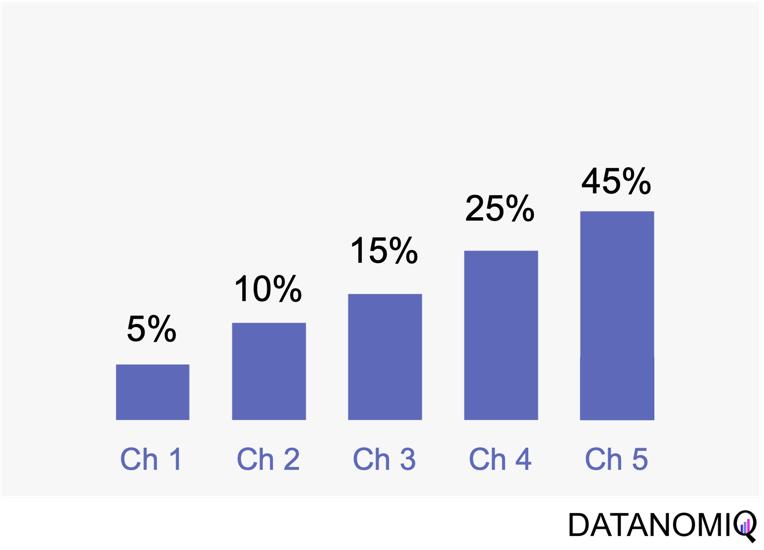
Figure 7 – Time-based models can be configurated by according to the first or last touch and weighted by the timespan in between of each touchpoint.
2.3 Data-Driven Attribution Models
2.3.1 Markov Chain Attribution
Markov chain attribution is a data-driven method that analyzes marketing effectiveness using the principles of Markov Chains. Those chains are mathematical models used to describe systems that transition from one state to another in a chain-like process. The principles focus on the transition matrix, derived from analyzing customer journeys from initial touchpoints to conversion or no conversion, to capture the sequential nature of interactions and understand how each touchpoint influences the final decision. Let’s have a look at the following simple example with three channels that are chained together and leading to either a conversion or no conversion.
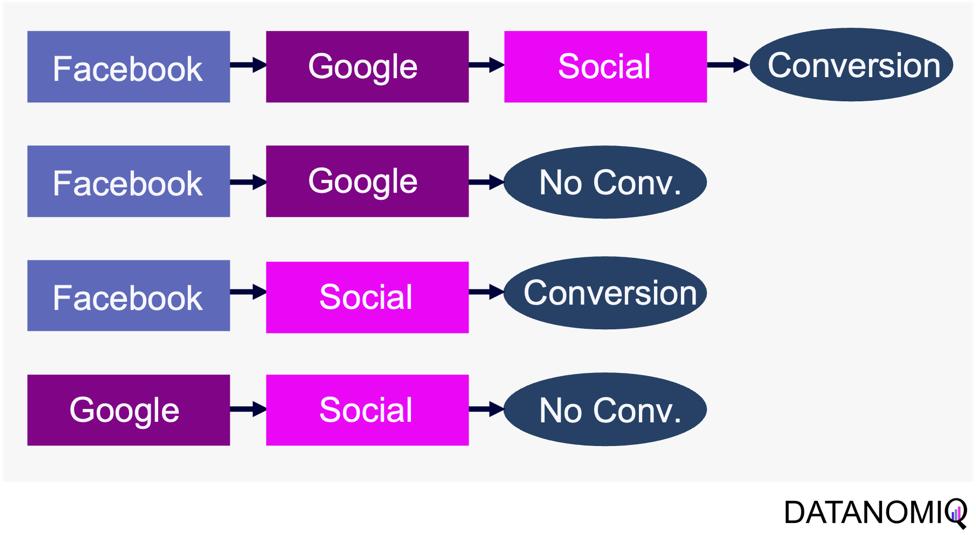
Figure 8 – Example of four customer journeys
The model calculates the conversion likelihood by examining transitions between touchpoints. Those transitions are depicted in the following probability tree.
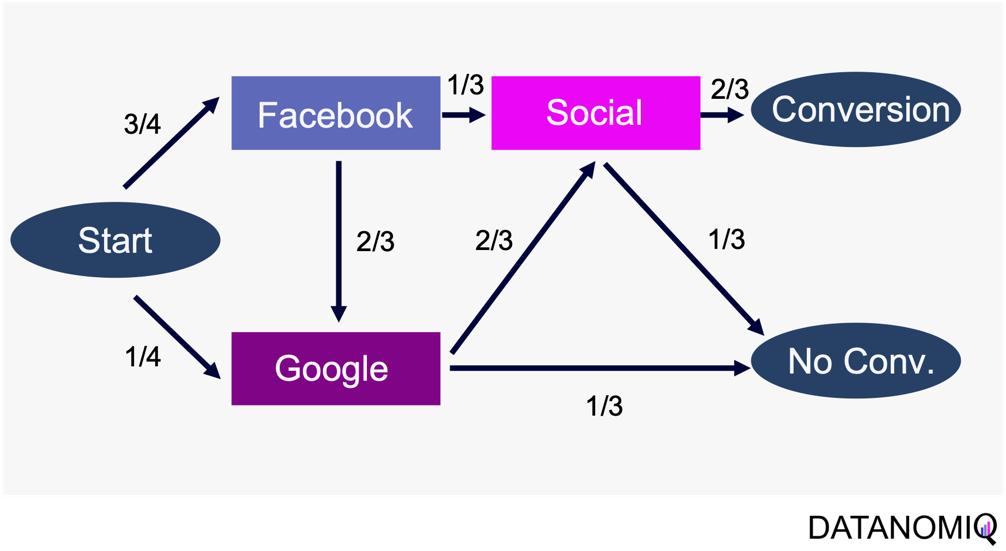
Figure 9 – Example of a touchpoint network based on customer journeys
Based on this tree, the transition matrix can be constructed that reveals the influence of each touchpoint and thus the significance of each channel.
This method considers the sequential nature of customer journeys and relies on historical data to estimate transition probabilities, capturing the empirical behavior of customers. It offers flexibility by allowing customization to incorporate factors like time decay, channel interactions, and different attribution rules.
Markov chain attribution can be extended to higher-order chains, where the probability of transition depends on multiple previous states, providing a more nuanced analysis of customer behavior. To do so, the Markov process introduces a memory parameter 0 that is assumed to be zero here. Overall, it offers a robust framework for understanding the influence of different marketing touchpoints.
2.3.2 Shapley Value Attribution (Game Theoretical Approach)
The Shapley value is a concept from game theory that provides a fair method for distributing rewards among participants in a coalition. It ensures that both gains and costs are allocated equitably among actors, making it particularly useful when individual contributions vary but collective efforts lead to a shared outcome. In advertising, the Shapley method treats the advertising channels as players in a cooperative game. Now, consider a channel coalition consisting of different advertising channels . The utility function describes the contribution of a coalition of channels .
In this formula, is the cardinality of a specific coalition and the sum extends over all subsets of that do not contain the marginal contribution of channel to the coalition . For more information on how to calculate the marginal distribution, see Zhao et al. (2018).
The Shapley value approach ensures a fair allocation of credit to each touchpoint based on its contribution to the conversion process. This method encourages cooperation among channels, fostering a collaborative approach to achieving marketing goals. By accurately assessing the contribution of each channel, marketers can gain valuable insights into the performance of their marketing efforts, leading to more informed decision-making. Despite its advantages, the Shapley value method has some limitations. The method can be sensitive to the order in which touchpoints are considered, potentially leading to variations in results depending on the sequence of attribution. This sensitivity can impact the consistency of the outcomes. Finally, Shapley value and Markov chain attribution can also be combined using an ensemble attribution model to further reduce the generalization error (Gaur & Bharti 2020).
2.33. Algorithmic Attribution using binary Classifier and (causal) Machine Learning
While customer journey data often suffices for evaluating channel contributions and strategy formulation, it may not always be comprehensive enough. Fortunately, companies frequently possess a wealth of additional data that can be leveraged to enhance attribution accuracy by using a variety of analytics data from various vendors. For examples, companies might collect extensive data, including customer website activity such as clicks, page views, and conversions. This data includes features like for example the Urchin Tracking Module (UTM) information such as source, medium, campaign, content and term as well as campaign, device type, geographical information, number of user engagements, and scroll frequency, among others.
Utilizing this information, a binary classification model can be trained to predict the probability of conversion at each step of the multi touch attribution (MTA) model. This approach not only identifies the most effective channels for conversions but also highlights overvalued channels. Common algorithms include logistic regressions to easily predict the probability of conversion based on various features. Gradient boosting also provides a popular ensemble technique that is often used for unbalanced data, which is quite common in attribution data. Moreover, random forest models as well as support vector machines (SVMs) are also frequently applied. When it comes to deep learning models, that are often used for more complex problems and sequential data, Long Short-Term Memory (LSTM) networks or Transformers are applied. Those models can capture the long-range dependencies among multiple touchpoints.
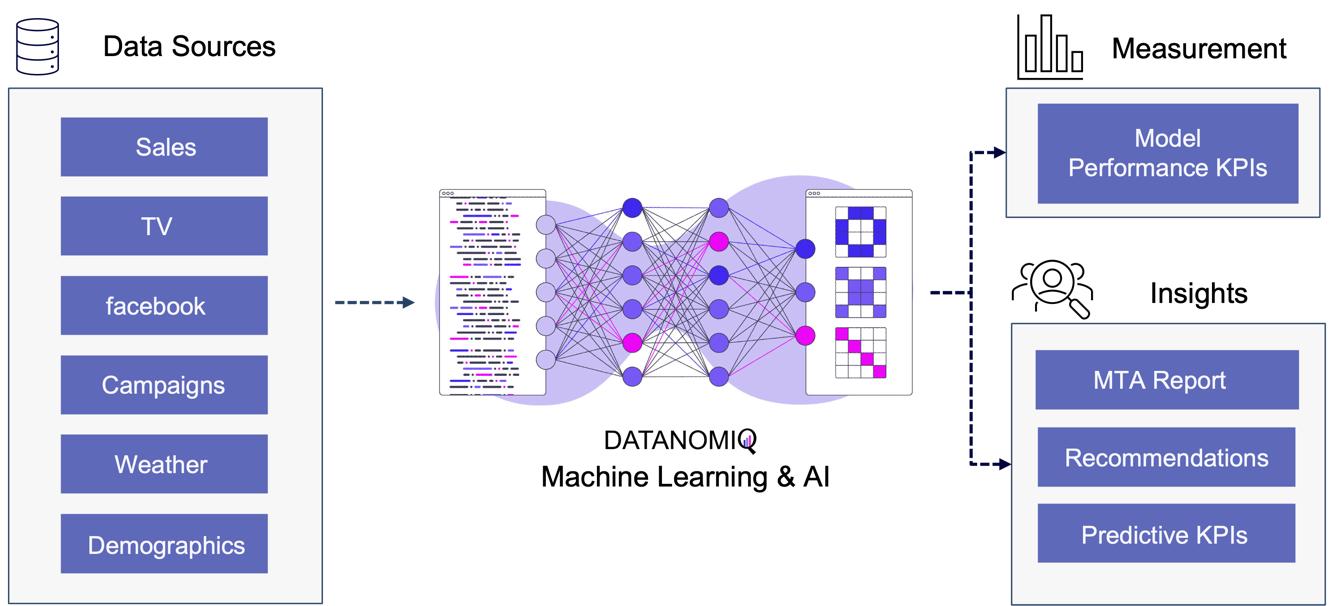
Figure 10 – Attribution Model based on Deep Learning / AI
The approach is scalable, capable of handling large volumes of data, making it ideal for organizations with extensive marketing campaigns and complex customer journeys. By leveraging advanced algorithms, it offers more accurate attribution of credit to different touchpoints, enabling marketers to make informed, data-driven decisions.
All those models are part of the Machine Learning & AI Toolkit for assessing MTA. And since the business world is evolving quickly, newer methods such as double Machine Learning or causal forest models that are discussed in the marketing literature (e.g. Langen & Huber 2023) in combination with eXplainable Artificial Intelligence (XAI) can also be applied as well in the DATANOMIQ Machine Learning and AI framework.
3. Conclusion
As digital marketing continues to evolve in the age of AI, attribution models remain crucial for understanding the complex customer journey and optimizing marketing strategies. These models not only aid in effective budget allocation but also provide a comprehensive view of how different channels contribute to conversions. With advancements in technology, particularly the shift towards data-driven and multi-touch attribution models, marketers are better equipped to make informed decisions that enhance quick return on investment (ROI) and maintain competitiveness in the digital landscape.
Several trends are shaping the evolution of attribution models. The increasing use of machine learning in marketing attribution allows for more precise and predictive analytics, which can anticipate customer behavior and optimize marketing efforts accordingly. Additionally, as privacy regulations become more stringent, there is a growing focus on data quality and ethical data usage (Ethical AI), ensuring that attribution models are both effective and compliant. Furthermore, the integration of view-through attribution, which considers the impact of ad impressions that do not result in immediate clicks, provides a more holistic understanding of customer interactions across channels. As these models become more sophisticated, they will likely incorporate a wider array of data points, offering deeper insights into the customer journey.
Unlock your marketing potential with a strategy session with our DATANOMIQ experts. Discover how our solutions can elevate your media-mix models and boost your organization by making smarter, data-driven decisions.
References
- Zhao, K., Mahboobi, S. H., & Bagheri, S. R. (2018). Shapley value methods for attribution modeling in online advertising. arXiv preprint arXiv:1804.05327.
- Gaur, J., & Bharti, K. (2020). Attribution modelling in marketing: Literature review and research agenda. Academy of Marketing Studies Journal, 24(4), 1-21.
- Langen H, Huber M (2023) How causal machine learning can leverage marketing strategies: Assessing and improving the performance of a coupon campaign. PLoS ONE 18(1): e0278937. https://doi.org/10.1371/journal. pone.0278937
Espresso AI: Q&A mit Mathias Golombek, CTO bei Exasol
/in Artificial Intelligence, Big Data, Business Analytics, Business Intelligence, Data Engineering, Data Science, Main Category/by RedaktionNahezu alle Unternehmen beschäftigen sich heute mit dem Thema KI und die überwiegende Mehrheit hält es für die wichtigste Zukunftstechnologie – dennoch tun sich nach wie vor viele schwer, die ersten Schritte in Richtung Einsatz von KI zu gehen. Woran scheitern Initiativen aus Ihrer Sicht?
Zu den größten Hindernissen zählen Governance-Bedenken, etwa hinsichtlich Themen wie Sicherheit und Compliance, unklare Ziele und eine fehlende Implementierungsstrategie. Mit seinen flexiblen Bereitstellungsoptionen in der Public/Private Cloud, on-Premises oder in hybriden Umgebungen macht Exasol seine Kunden unabhängig von bestimmten Plattform- und Infrastrukturbeschränkungen, sorgt für die unkomplizierte Integration von KI-Funktionalitäten und ermöglicht Zugriff auf Datenerkenntnissen in real-time – und das, ohne den gesamten Tech-Stack austauschen zu müssen.
Dies ist der eine Teil – der technologische Teil – die Schritte, die die Unternehmen –selbst im Vorfeld gehen müssen, sind die Festlegung von klaren Zielen und KPIs und die Etablierung einer Datenkultur. Das Management sollte für Akzeptanz sorgen, indem es die Vorteile der Nutzung klar beleuchtet, Vorbehalte ernst nimmt und sie ausräumt. Der Weg zum datengetriebenen Unternehmen stellt für viele, vor allem wenn sie eher traditionell aufgestellt sind, einen echten Paradigmenwechsel dar. Führungskräfte sollten hier Orientierung bieten und klar darlegen, welche Rolle die Nutzung von Daten und der Einsatz neuer Technologien für die Zukunftsfähigkeit von Unternehmen und für jeden Einzelnen spielen. Durch eine Kultur der offenen Kommunikation werden Teams dazu ermutigt, digitale Lösungen zu finden, die sowohl ihren individuellen Anforderungen als auch den Zielen des Unternehmens entsprechen. Dazu gehört es natürlich auch, die eigenen Teams zu schulen und mit dem entsprechenden Know-how auszustatten.
Wie unterstützt Exasol die Kunden bei der Implementierung von KI?
Datenabfragen in natürlicher Sprache können, das ist spätestens seit dem Siegeszug von ChatGPT klar, generativer KI den Weg in die Unternehmen ebnen und ihnen ermöglichen, sich datengetrieben aufzustellen. Mit der Integration von Veezoo sind auch die Kunden von Exasol Espresso in der Lage, Datenabfragen in natürlicher Sprache zu stellen und KI unkompliziert in ihrem Arbeitsalltag einzusetzen. Mit dem integrierten autoML-Tool von TurinTech können Anwender zudem durch den Einsatz von ML-Modellen die Performance ihrer Abfragen direkt in ihrer Datenbank maximieren. So gelingt BI-Teams echte Datendemokratisierung und sie können mit ML-Modellen experimentieren, ohne dabei auf Support von ihren Data-Science-Teams angewiesen zu sei.
All dies trägt zur Datendemokratisierung – ein entscheidender Punkt auf dem Weg zum datengetriebenen Unternehmen, denn in der Vergangenheit scheiterte die Umsetzung einer unternehmensweiten Datenstrategie häufig an Engpässen, die durch Data Analytics oder Data Science Teams hervorgerufen werden. Espresso AI ermöglicht Unternehmen einen schnelleren und einfacheren Zugang zu Echtzeitanalysen.
Was war der Grund, Exasol Espresso mit KI-Funktionen anzureichern?
Immer mehr Unternehmen suchen nach Möglichkeiten, sowohl traditionelle als auch generative KI-Modelle und -Anwendungen zu entwickeln – das entsprechende Feedback unserer Kunden war einer der Hauptfaktoren für die Entwicklung von Espresso AI.
Ziel der Unternehmen ist es, ihre Datensilos aufzubrechen – oft haben Data Science Teams viele Jahre lang in Silos gearbeitet. Mit dem Siegeszug von GenAI durch ChatGPT hat ein deutlicher Wandel stattgefunden – KI ist greifbarer geworden, die Technologie ist zugänglicher und auch leistungsfähiger geworden und die Unternehmen suchen nach Wegen, die Technologie gewinnbringend einzusetzen.
Um sich wirklich datengetrieben aufzustellen und das volle Potenzial der eigenen Daten und der Technologien vollumfänglich auszuschöpfen, müssen KI und Data Analytics sowie Business Intelligence in Kombination gebracht werden. Espresso AI wurde dafür entwickelt, um genau das zu tun.
Und wie sieht die weitere Entwicklung aus? Welche Pläne hat Exasol?
Eines der Schlüsselelemente von Espresso AI ist das AI Lab, das es Data Scientists ermöglicht, die In-Memory-Analytics-Datenbank von Exasol nahtlos und schnell in ihr bevorzugtes Data-Science-Ökosystem zu integrieren. Es unterstützt jede beliebige Data-Science-Sprache und bietet eine umfangreiche Liste von Technologie-Integrationen, darunter PyTorch, Hugging Face, scikit-learn, TensorFlow, Ibis, Amazon Sagemaker, Azure ML oder Jupyter.
Weitere Integrationen sind ein wichtiger Teil unserer Roadmap. Während sich die ersten auf die Plattformen etablierter Anbieter konzentrierten, werden wir unser AI Lab weiter ausbauen und es werden Integrationen mit Open-Source-Tools erfolgen. Nutzer werden so in der Lage sein, eine Umgebung zu schaffen, in der sich Data Scientists wohlfühlen. Durch die Ausführung von ML-Modellen direkt in der Exasol-Datenbank können sie so die maximale Menge an Daten nutzen und das volle Potenzial ihrer Datenschätze ausschöpfen.
 Über Exasol-CEO Martin Golombek
Über Exasol-CEO Martin Golombek
Mathias Golombek ist seit Januar 2014 Mitglied des Vorstands der Exasol AG. In seiner Rolle als Chief Technology Officer verantwortet er alle technischen Bereiche des Unternehmens, von Entwicklung, Produkt Management über Betrieb und Support bis hin zum fachlichen Consulting.
Über Exasol und Espresso AI
Sie leiden unter langsamer Business Intelligence, mangelnder Datenbank-Skalierung und weiteren Limitierungen in der Datenanalyse? Exasol bietet drei Produkte an, um Ihnen zu helfen, das Maximum aus Analytics zu holen und schnellere, tiefere und kostengünstigere Insights zu erzielen.
Kein Warten mehr auf das “Spinning Wheel”. Von Grund auf für Geschwindigkeit konzipiert, basiert Espresso auf einer einmaligen Datenbankarchitektur aus In-Memory-Caching, spaltenorientierter Datenspeicherung, “Massively Parallel Processing” (MPP), sowie Auto-Tuning. Damit können selbst die komplexesten Analysen beschleunigt und bessere Erkenntnisse in atemberaubender Geschwindigkeit geliefert werden.
Data Science – Weiterbildungen mit Coursera
/in Certification / Training, Education / Certification/by RedaktionAnzeige
Data Science und AI sind aufstrebende Arbeitsfelder, die sich mit der Gewinnung von Wissen aus Daten beschäftigen. Die Nachfrage nach Fähigkeiten im Bereich Data Science, aber auch in angrenzenden Bereichen wie Data Engineering oder Data Analytics, ist in den letzten Jahren explodiert, da Unternehmen versuchen, die Vorteile von Big Data und künstlicher Intelligenz (KI) zu nutzen. Es lohnt sich sehr, sich in diesen Bereich weiter zu entwickeln. Dafür eignen sich die Kurse von Coursera.org.
Online-Kurse lohnen sich dann, wenn eine Karriere im Bereich der Datenanalyse oder des maschinellen Lernens angestrebt oder einfach nur ihr Wissen in diesem Bereich erweitert werden soll.
Spezialisierungskurs – Google Data Analytics
Data Science hilft dabei, Entscheidungen auf Basis von Daten zu treffen, komplexe Probleme effektiver zu lösen und Karrierechancen zu verbessern. Die Tools von Google Cloud und Jupyter Notebook sind dafür geeignet, da sie eine leistungsstarke und skalierbare Infrastruktur sowie eine interaktive Entwicklungsplattform bieten.
Das Google Zertifikat für Datenanalyse behandelt neben dem Handwerkszeug für jeden Data Analyst – wie etwa SQL – auch die notwendige Datenbereinigung und Datenvisualisierung mit den Tools von Google. Es werden weder Erfahrung noch Vorkenntnisse vorausgsetzt.
Spezialisierungskurs – Google Advanced Data Analytics
Der Zertifikatskurs der erweiterten Datenanalyse von Google baut auf dem zuvorgenannten Data Analytics Kurs auf, kann jedoch auch direkt besucht werden. Hier werden grundlegende Fähigkeiten wie SQL vorausgesetzt und vertiefende Fähigkeiten vermittelt, die für einen Data Analysten nützlich sind und auch in die Data Science eintauchen.

Dieses Kursangebot zum Aufbau erweiterter Datenanalyse-Fähigkeiten von Coursera wird ebenfalls von Google angeboten. Hier werden die Tools der Datenanalyse sowie der statistischen Handwerkzeuge für Data Science eingeführt, bis hin zum ersten Einstieg in Machine Learning.
Spezialisierungskurs – SQL für Data Science (Generalistisch)
SQL ist wichtig für etablierte und angehende Data Scientists, da es eine grundlegende Technologie für die Arbeit mit Datenbanken und relationalen Datenbankmanagementsystemen ist. SQL für Data Science ermöglicht, Daten effektiv zu organisieren und schnell Abfragen zu erstellen, um Antworten auf komplexe Fragen zu finden. Es ist auch relevant für die Arbeit mit nicht-relationalen Datenbanken und hilft Data Scientists, wertvolle Erkenntnisse aus großen Datenmengen zu gewinnen.
Auch wenn Python als Skill für einen Data Scientist ganz vorne steht, ist eine Karriere als Data Scientist ohne SQL-Kenntnisse nicht vorstellbar und dieser Kurs daher der richtige, wenn Nachbolbedarf besteht.
Spezialisierungskurs – Data Analyst Zertifikat (IBM)
Eine Karriere als Data Analyst ist attraktiv, da ihr eine hohe Nachfrage am Arbeitsmarkt gegenüber steht, die Arbeit vielfältig und herausfordernd ist, viele Weiterentwicklungsmöglichkeiten (z. B. zum Data Scientist) bietet und oft flexibel ist.
Der Online-Kurs von IBM bietet die Ausbildung der beruflichen Qualifikation zum Data Analyst. Ein weiterer Vorteil dieses Kurses ist, dass er für alle geeignet ist – unabhängig von ihrem Hintergrund oder der Vorbildung. Es sind keine Abschlüsse oder Vorkenntnisse erforderlich, was bedeutet, dass jeder, der sich für das Thema interessiert, am Kurs teilnehmen und von ihm profitieren kann.
Spezialisierungskurs – Datenverarbeitung mit Python & SQL (IBM)
Dieser Kurs bietet den Teilnehmern die Möglichkeit, ihre Kenntnisse in der Datenverarbeitung zu verbessern, eine Programmiersprache wie Python zu erlernen und grundlegende Kenntnisse in SQL zu erwerben. Diese Fähigkeiten sind für die Arbeit mit Daten unerlässlich und in der heutigen Arbeitswelt sehr gefragt. Darüber hinaus bietet der Kurs für Datenverarbeitung mit Python und SQL auch Schulungen zur Analyse und Visualisierung von Daten sowie zur Erstellung von Modellen für Maschinelles Lernen. Diese Fähigkeiten sind besonders wertvoll für die Entwicklung von Anwendungen und Systemen im Bereich der KI.
Dieser Kurs ist eine großartige Möglichkeit für alle, die ihre Kenntnisse im Bereich der Datenverarbeitung und des maschinellen Lernens verbessern möchten. Zwar werden auch hier keine Vorkenntnisse vorausgesetzt, jedoch geht der Kurs inhaltlich mehr in die Richtung Data Science als der zuvorgenannte Kurs zum Data Analyst und bietet ein umfassendes Training und Schulungen zu grundlegenden Fähigkeiten, die in der heutigen Arbeitswelt gefragt sind, und ist für jeden zugänglich, unabhängig von Hintergrund oder Erfahrung.
Spezialisierungskurs – Maschinelles Lernen (DeepLearning.AI)
Das Erlernen der Grundlagen des maschinellen Lernens (Machine Learning) ist von großer Bedeutung, da es eine der am schnellsten wachsenden und wichtigsten Technologien in der heutigen Zeit ist. Maschinelles Lernen ermöglicht es Computern, aus Erfahrung zu lernen, ohne explizit programmiert zu werden. Die Teilnehmer lernen, dem Computer das lernen zu ermöglichen.
Machinelles Lernen ist der Schlüssel zur Entwicklung von Anwendungen und Systemen im Bereich der künstlichen Intelligenz (KI) und hat Anwendungen in vielen Bereichen, von der Gesundheitsversorgung und der Finanzindustrie bis hin zur Unterhaltungsbranche und der Automobilindustrie.
Der Kurs für Maschinelles Lernen ist nicht nur ein sinnvoller Einstieg in diese Materie, sondern kann darauf aufbauend mit dem Thema Deep Learning in der Qualifikation erweitert werden.
Spezialisierungskurs – Deep Learning (DeepLearning.AI)
Das Verständnis von Deep Learning ist wichtig, da es eine Unterkategorie des maschinellen Lernens ist und viele noch mächtigere Anwendungen in verschiedenen Bereichen hat. Die populäre Applikation ChatGPT ist ein Produkt des Deep Learning. Deep Learning kann mit AI gleichgesetzt werden. Es ist eine gefragte Fähigkeit auf dem Arbeitsmarkt mit Job-Garantie.
Der Spezialisierungskurs für Deep Learning steht unabhängig für sich und erfordert keine speziellen Vorkenntnisse, darf jedoch auch als sinnvolle Ergänzung zum vorgenannten Einführungskurs in Machine Learning betrachtet werden.
Weitere Kursangebote für Data & AI auf Coursera
Die Entscheidung für ein bestimmtes Thema eines Kurses in den Bereichen Data Analytics, Data Science und AI ist eine persönliche und abhängig von den eigenen Vorkenntnissen und Vorlieben, sowie den eigenen Karrierezielen. Für die Karriere des Data Analyst sind SQL sowie allgemeine Kenntnisse rund um Data Analytics bzw. Datenverarbeitung wichtig. Von einem Data Scientist wird ferner erwartet, die theoretischen Grundlagen sowie die praktische Anwendung von Machine Learning und Deep Learning als trainierte Fähigkeit abrufbar zu haben.
Weitere Kurse von Coursera zum Thema Data & AI (link).
Dieser Artikel wurde gesponsored von Coursera.
Big Data – Das Versprechen wurde eingelöst
/in Artificial Intelligence, Big Data, Business Analytics, Business Intelligence, Cloud, Data Engineering, Data Science, Data Warehousing, Deep Learning, Insights, Machine Learning, Main Category/by Benjamin AunkoferBig Data tauchte als Buzzword meiner Recherche nach erstmals um das Jahr 2011 relevant in den Medien auf. Big Data wurde zum Business-Sprech der darauffolgenden Jahre. In der Parallelwelt der ITler wurde das Tool und Ökosystem Apache Hadoop quasi mit Big Data beinahe synonym gesetzt. Der Guardian verlieh Apache Hadoop mit seinem Konzept des Distributed Computing mit MapReduce im März 2011 bei den MediaGuardian Innovation Awards die Auszeichnung “Innovator of the Year”. Im Jahr 2015 erlebte der Begriff Big Data in der allgemeinen Geschäftswelt seine Euphorie-Phase mit vielen Konferenzen und Vorträgen weltweit, die sich mit dem Thema auseinandersetzten. Dann etwa im Jahr 2018 flachte der Hype um Big Data wieder ab, die Euphorie änderte sich in eine Ernüchterung, zumindest für den deutschen Mittelstand. Die große Verarbeitung von Datenmassen fand nur in ganz bestimmten Bereichen statt, die US-amerikanischen Tech-Riesen wie Google oder Facebook hingegen wurden zu Daten-Monopolisten erklärt, denen niemand das Wasser reichen könne. Big Data wurde für viele Unternehmen der traditionellen Industrie zur Enttäuschung, zum falschen Versprechen.
Von Big Data über Data Science zu AI
Einer der Gründe, warum Big Data insbesondere nach der Euphorie wieder aus der Diskussion verschwand, war der Leitspruch “Shit in, shit out” und die Kernaussage, dass Daten in großen Mengen nicht viel wert seien, wenn die Datenqualität nicht stimme. Datenqualität hingegen, wurde zum wichtigen Faktor jeder Unternehmensbewertung, was Themen wie Reporting, Data Governance und schließlich dann das Data Engineering mehr noch anschob als die Data Science.
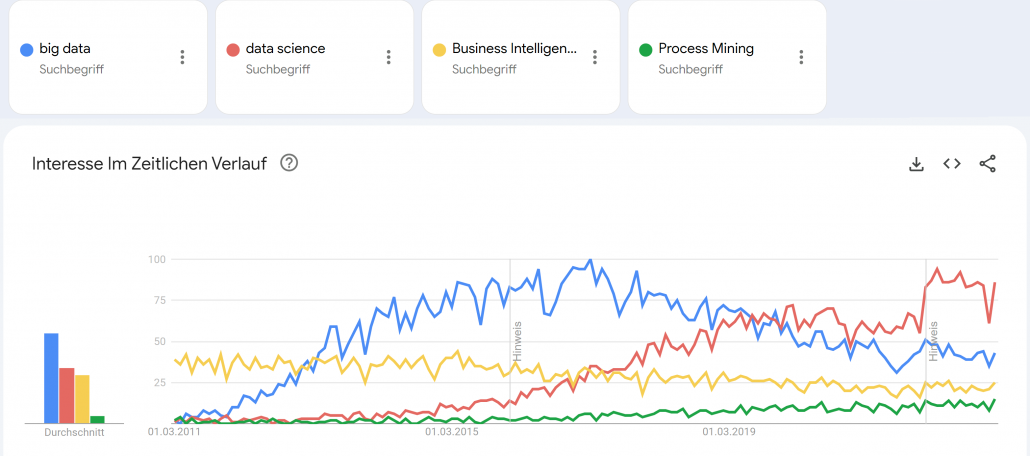
Google Trends – Big Data (blue), Data Science (red), Business Intelligence (yellow) und Process Mining (green). Quelle: https://trends.google.de/trends/explore?date=2011-03-01%202023-01-03&geo=DE&q=big%20data,data%20science,Business%20Intelligence,Process%20Mining&hl=de
Small Data wurde zum Fokus für die deutsche Industrie, denn “Big Data is messy!”1 und galt als nur schwer und teuer zu verarbeiten. Cloud Computing, erst mit den Infrastructure as a Service (IaaS) Angeboten von Amazon, Microsoft und Google, wurde zum Enabler für schnelle, flexible Big Data Architekturen. Zwischenzeitlich wurde die Business Intelligence mit Tools wie Qlik Sense, Tableau, Power BI und Looker (und vielen anderen) weiter im Markt ausgebaut, die recht neue Disziplin Process Mining (vor allem durch das deutsche Unicorn Celonis) etabliert und Data Science schloss als Hype nahtlos an Big Data etwa ab 2017 an, wurde dann ungefähr im Jahr 2021 von AI als Hype ersetzt. Von Data Science spricht auf Konferenzen heute kaum noch jemand und wurde hype-technisch komplett durch Machine Learning bzw. Artificial Intelligence (AI) ersetzt. AI wiederum scheint spätestens mit ChatGPT 2022/2023 eine neue Euphorie-Phase erreicht zu haben, mit noch ungewissem Ausgang.
Big Data Analytics erreicht die nötige Reife
Der Begriff Big Data war schon immer etwas schwammig und wurde von vielen Unternehmen und Experten schnell auch im Kontext kleinerer Datenmengen verwendet.2 Denn heute spielt die Definition darüber, was Big Data eigentlich genau ist, wirklich keine Rolle mehr. Alle zuvor genannten Hypes sind selbst Erben des Hypes um Big Data.
Während vor Jahren noch kleine Datenanalysen reichen mussten, können heute dank Data Lakes oder gar Data Lakehouse Architekturen, auf Apache Spark (dem quasi-Nachfolger von Hadoop) basierende Datenbank- und Analysesysteme, strukturierte Datentabellen über semi-strukturierte bis komplett unstrukturierte Daten umfassend und versioniert gespeichert, fusioniert, verknüpft und ausgewertet werden. Das funktioniert heute problemlos in der Cloud, notfalls jedoch auch in einem eigenen Rechenzentrum On-Premise. Während in der Anfangszeit Apache Spark noch selbst auf einem Hardware-Cluster aufgesetzt werden musste, kommen heute eher die managed Cloud-Varianten wie Microsoft Azure Synapse oder die agnostische Alternative Databricks zum Einsatz, die auf Spark aufbauen.
Die vollautomatisierte Analyse von textlicher Sprache, von Fotos oder Videomaterial war 2015 noch Nische, gehört heute jedoch zum Alltag hinzu. Während 2015 noch von neuen Geschäftsmodellen mit Big Data geträumt wurde, sind Data as a Service und AI as a Service heute längst Realität!
ChatGPT und GPT 4 sind King of Big Data
ChatGPT erschien Ende 2022 und war prinzipiell nichts Neues, keine neue Invention (Erfindung), jedoch eine große Innovation (Marktdurchdringung), die großes öffentliches Interesse vor allem auch deswegen erhielt, weil es als kostenloses Angebot für einen eigentlich sehr kostenintensiven Service veröffentlicht und für jeden erreichbar wurde. ChatGPT basiert auf GPT-3, die dritte Version des Generative Pre-Trained Transformer Modells. Transformer sind neuronale Netze, sie ihre Input-Parameter nicht nur zu Klasseneinschätzungen verdichten (z. B. ein Bild zeigt einen Hund, eine Katze oder eine andere Klasse), sondern wieder selbst Daten in ähnliche Gestalt und Größe erstellen. So wird aus einem gegeben Bild ein neues Bild, aus einem gegeben Text, ein neuer Text oder eine sinnvolle Ergänzung (Antwort) des Textes. GPT-3 ist jedoch noch komplizierter, basiert nicht nur auf Supervised Deep Learning, sondern auch auf Reinforcement Learning.
GPT-3 wurde mit mehr als 100 Milliarden Wörter trainiert, das parametrisierte Machine Learning Modell selbst wiegt 800 GB (quasi nur die Neuronen!)3.
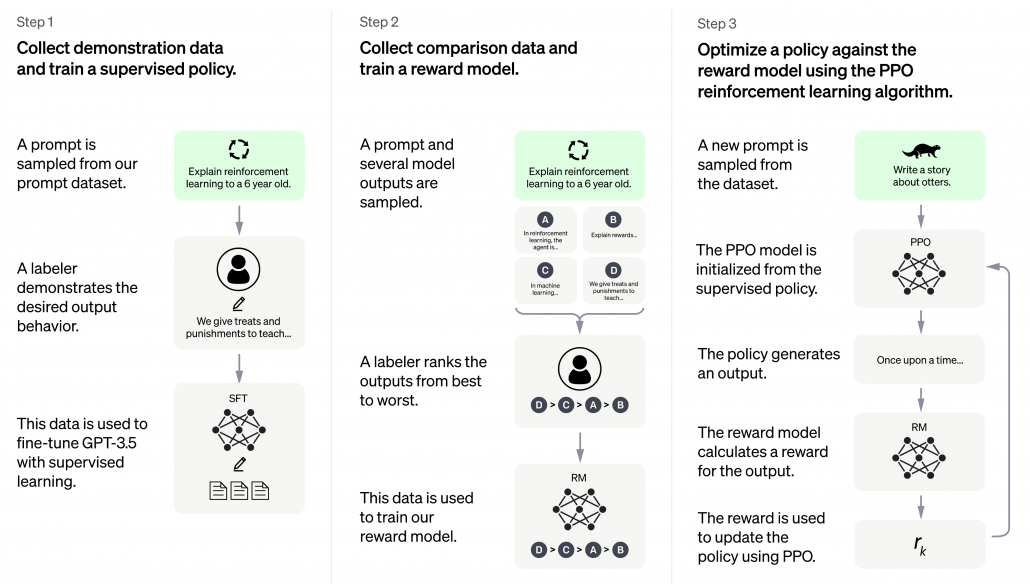
ChatGPT basiert auf GPT-3.5 und wurde in 3 Schritten trainiert. Neben Supervised Learning kam auch Reinforcement Learning zum Einsatz. Quelle: openai.com
GPT-3 von openai.com war 2021 mit 175 Milliarden Parametern das weltweit größte Neuronale Netz der Welt.4

Größenvergleich: Parameteranzahl GPT-3 vs GPT-4 Quelle: openai.com
Der davor existierende Platzhirsch unter den Modellen kam von Microsoft mit “nur” 10 Milliarden Parametern und damit um den Faktor 17 kleiner. Das nun neue Modell GPT-4 ist mit 100 Billionen Parametern nochmal 570 mal so “groß” wie GPT-3. Dies bedeutet keinesfalls, dass GPT-4 entsprechend 570 mal so fähig sein wird wie GPT-3, jedoch wird der Faktor immer noch deutlich und spürbar sein und sicher eine Erweiterung der Fähigkeiten bedeuten.
Was Big Data & Analytics heute für Unternehmen erreicht
Auf Big Data basierende Systeme wie ChatGPT sollte es – der zuvor genannten Logik folgend – jedoch eigentlich gar nicht geben dürfen, denn die rohen Datenmassen, die für das Training verwendet wurden, konnten nicht im Detail auf ihre Qualität überprüft werden. Zum Einen mittelt die Masse an Daten die in ihnen zu findenden Fehler weitgehend raus, zum Anderen filtert Deep Learning selbst relevante Muster und unliebsame Ausreißer aus den Datenmassen heraus. Neuronale Netze, der Kern des Deep Learning, können durchaus als große Filter verstanden und erklärt werden.
Davon abgesehen, dass die neuen ChatBot-APIs von den Cloud-Providern Microsoft, Google und auch Amazon genutzt werden können, um Arbeitsprozesse und Kommunikation zu automatisieren, wird Big Data heute in vielen Unternehmen dazu eingesetzt, um Unternehmens-/Finanzkennzahlen auszuwerten und vorherzusagen, um Produktionsqualität zu überwachen, um Maschinen-Sensordaten mit den Geschäftsdaten aus ERP-, MES- und CRM-Systemen zu verheiraten, um operative Prozesse über mehrere IT-Systeme hinweg zu rekonstruieren und auf Schwachstellen hin zu untersuchen und um Schlussendlich auch den weiteren Datenhunger zu stillen, z. B. über Text-Extraktion aus Webseiten (Intelligence Gathering), die mit NLP und Computer Vision mächtiger wird als je zuvor.
Big Data hält sein Versprechen dank AI
Die frühere Enttäuschung aus Big Data resultierte aus dem fehlenden Vermittler zwischen Big Data (passive Daten) und den Applikationen (z. B. Industrie 4.0). Dieser Vermittler ist der aktive Part, die AI und weiterführende Datenverarbeitung (z. B. Lakehousing) und Analysemethodik (z. B. Process Mining). Davon abgesehen, dass mit AI über Big Data bereits in Medizin und im Verkehrswesen Menschenleben gerettet wurden, ist Big Data & AI längst auch in gewöhnlichen Unternehmen angekommen. Big Data hält sein Versprechen für Unternehmen doch noch ein und revolutioniert Geschäftsmodelle und Geschäftsprozesse, sichert so Wettbewerbsfähigkeit. Zumindest, wenn Unternehmen sich auf diesen Weg tatsächlich einlassen.
Quellen:
- Edd Dumbill: What is big data? An introduction to the big data landscape. (Memento vom 23. April 2014 im Internet Archive) auf: strata.oreilly.com.
↑ - Fergus Gloster: Von Big Data reden aber Small Data meinen. Computerwoche, 1. Oktober 2014↑
- Bussler, Frederik (July 21, 2020). “Will GPT-3 Kill Coding?”. Towards Data Science. Retrieved August 1, 2020.2022↑
- developer.nvidia.com, 1. Oktober 2014↑
How to tackle lack of data: an overview on transfer learning
/in Artificial Intelligence, Data Mining, Data Science, Deep Learning, Machine Learning, Predictive Analytics, Reinforcement Learning/by Yasuto Tamura1, Data is the new oil, but labeled data might be closer to it
Even though we have been in the 3rd AI boom and machine learning is showing concrete effectiveness at a commercial level, after the first two AI booms we are facing a problem: lack of labeled data or data themselves. The increasing number of papers on deep learning demonstrate that researches on AI have developed rapidly recently. If architectures of neural networks and supervised learning are all you know about deep learning, you will be overwhelmed by complications of topics studied these days, for example generative models, making more compact neural net models by for example knowledge distillation, and explainable AI (XAI). Those researches are often conducted on easily available benchmark datasets which you can easily download, often with corresponding ground truth data (label data) necessary for training. However once you try to apply the techniques to more specific data, you usually cannot prepare enough label data which theoretical researches assume. Thus among fascinating deep learning topics, in this article I am going to pick up how to tackle lack of label or data themselves, and transfer learning. Transfer learning is a technique of machine learning to take advantages of knowledge learned in one dataset to deal with a task in another dataset. Presumably due to this fact, Andrew Ng, in his presentation in NeurIPS 2016, gave a rough and abstract predictions of how transfer learning in machine learning would make commercial success like white lines in the figure below. The explanation is straightforward, and given the trends in topics of researches on machine learning these days, this prediction is actually right. But at the same time, in my opinion supervised learning, transfer learning, and unsupervised learning cannot be clearly separated like the graph originally suggested by Andrew Ng. Those fields complement each other, and one can easily shift to another.
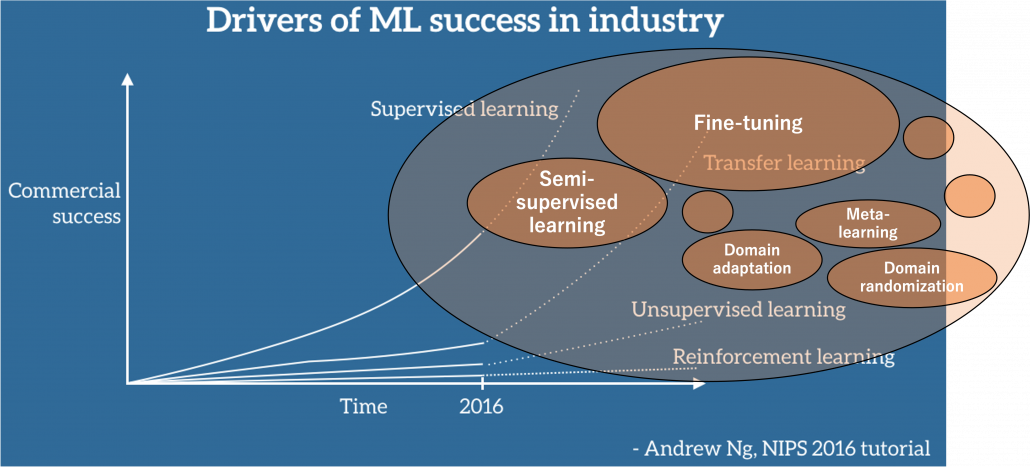
Source: https://ruder.io/transfer-learning/ The lines and texts in white are based on explanations by Andrew Ng. The orange cells are placed at random, so not that they represent commercial success of each field.
Along with the rapid progress of deep learning mentioned above, a lot of hypes and catchphrases regarding big data and machine learning were made, and an interesting one is “Data is the new oil.” That might have been said only because big data is sources of various industries. But I would say, the characteristic is more striking in training data for machine learning. Distributions of training data for machine learning are more complicated like various energy resources besides oil in the world. Labeled data might be also like uranium. Just as uranium-235 accounting for only less than one percent of uranium in the world can be used to generate energy, only a part of massive data in the world is labeled such that they can be used for supervised machine learning. And as uranium-235 is used effectively jointly with less active uranium-238, labeled data show greater potentials with unlabeled data. And training data for machine learning have another unpleasant analogy to energy resources. Like most mainstream energy resources, only limited companies or institutions would be able to mine and refine huge labeled datasets with gigantic computation resources, and most people more or less need to rely on that for their business. Even though alternative renewable energy resources are proposed, principal energy resources are indispensable for making industries stable. As well, even though a lot of techniques actually have been proposed to lack of data, it often turns out just fine-tuning pre-trained models is the most practical, which need huge datasets and rich computational resources. And I think recent success in for example BERT or GPT made this trend more visible.
*I am sorry in a case I am mistaken about energy resources. I just wanted to come up with some cool metaphors.
But I still think knowing about transfer learning more comprehensively would be effective. That is partly because I have been working on relatively unique data which are hard to even label. As I was studying computer vision (CV) in plant science field, I frequently saw relatively unique data obtained with special apparatuses. Such data are for the most part look far from very general dataset, which huge pre-trained models are trained on. At the same time such plant data have very complicated structures and hard to label. And also in my work, have to detect certain values in various formats in very specific documents, in German. Such data are far from general datasets, and even labeling is hard in that case. We have to carefully tackle lack of data every time on each type of data in that case.
In this article I would first like to explain in the first place what it is like to lack data and next introduce representative techniques to tackle lack of labeled data. Many of them are classified to transfer learning, but other techniques like unsupervised learning or self-supervised learning are used in them or share a lot in their ideas. Thus my main purpose of writing this article is to let you have a richer view on transfer learning. And you would see “transfer learning” these days are mainly about fine-tuning of pre-trained models. Also how to tackle lack of data or labels is in other words how to efficiently achieve good performance in machine learning. Thus even if tons of high quality labeled data are at your disposal, learning those ideas would be still effective to you. I hope you could find some hints of machine learning through my articles.
2, What does lack of data or labels mean in the first place?
We need to first consider what lack of labels or data means, and my answer to the title of this section is “It depends.” The more data you have, the better performances you get. And the bigger machine learning models are, the more data they usually need for training. I assume that people reading this article more or less understand neural networks and how they are trained with back propagation. But let’s review the process here. Most machine learning frameworks are more or less expressed like the figure below unless reinforcement learning is considered. The ultimate purpose of machine learning is to train a model ![]() by adjusting parameters
by adjusting parameters ![]() . And the parameters
. And the parameters ![]() are optimized so that a loss function
are optimized so that a loss function ![]() is minimized. If it is a supervised learning, the a value of a loss function is denoted
is minimized. If it is a supervised learning, the a value of a loss function is denoted ![]()
![]() , and it gets smaller as
, and it gets smaller as ![]() gets closer to
gets closer to ![]() . That is,
. That is, ![]() is giving supervision to adjust
is giving supervision to adjust ![]() via
via ![]() . And in a case of unsupervised learning, a loss function is
. And in a case of unsupervised learning, a loss function is ![]() , which is often heuristically handcrafted.
, which is often heuristically handcrafted.

The very first problem from lacking training data you would learn is overfitting. That is, a machine learning model can be specialized too much for a training dataset, and it loses generalization to other data from the same dataset. It is like students with little imaginations and flexibility gradually memorizing all the answers in a textbook and failing to answer new questions they have not encountered yet. Overfitting is judged by relations of training and validation loss like in the graph below. Training loss in blue indicates how the students adjust to the textbook. The smaller the training loss is, the more they memorizes from the textbook and the less flexible they are. The orange line indicates their performance in newly appeared questions in tests. The smaller the validation loss is, the better the students perform on tests. Thus the students should stop learning with the textbook when the validation loss is about to increase. This is called early stopping in machine learning. And if you increase training data, the orange graph usually shifts to the right side, usually providing smaller validation loss, namely better performance. An important point is, this ideal relations of training and validation losses will not appear if sizes or expressivity of a model is not enough. Thus the more training data you use, the more parameters you need for the model to enhance its expressivity.
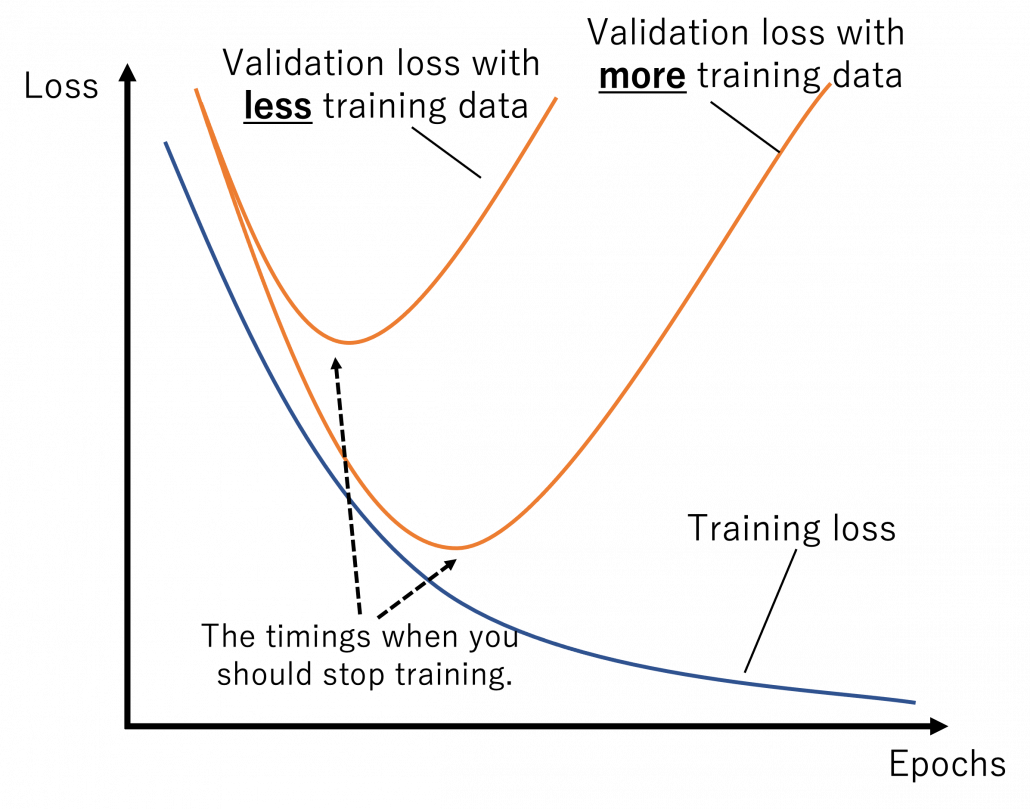
*Depending on sizes of training data, the curve of training loss also changes, so please bear it in mind that this graph is not correct and is very simplified.
What I said so far might sound too elementary. My point is, the more data you have, and the bigger computation resource you have, the better performance you get. In other words, machine learning has scalability with data and parameters. This characteristic is clearly observed in models in natural language processing (NLP) and computer vision (CV) like in the graphs below. When I read some papers,often I am very fascinated by their performances. But sometimes it turns out that the methods are mainly creatively in terms of how they increase training data, which is personally boring. And even if performance of GPT looks astonishing, I cannot really like them because of this simple fact.
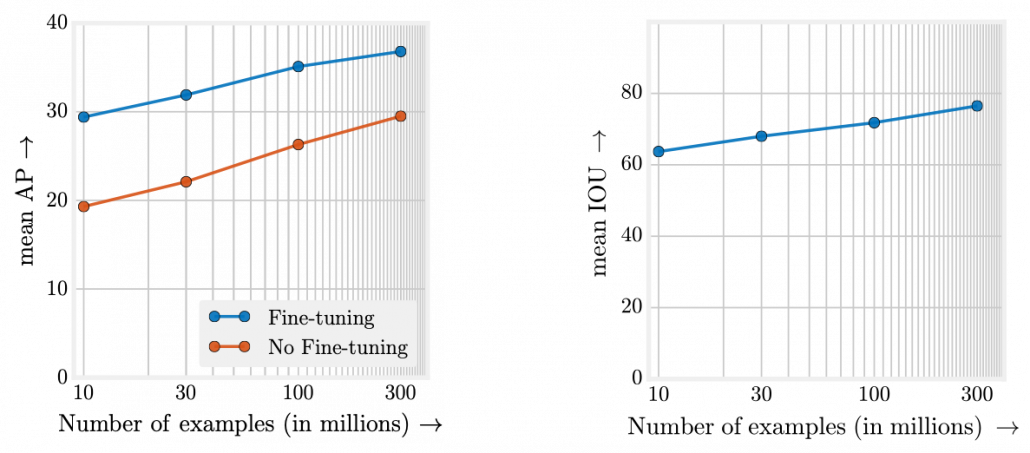
However another important point is, conversely you don’t need to increase training data or parameters of a model once it achieves an ideal score in metrics. When you make a toy model with small training data, as long as your clients or co-researchers are already happy, that is enough. Therefore lack of data or labels has to be discussed depending on sizes of machine learning and their performances you expect. Given those points mentioned so far, my answer to the question “What does lack of data or labels mean?” would rephrased like “If your model is properly designed to reach the performance you expect and it starts overfitting, you are facing lack of data.” And such decisions basically has to be made based on experiments.
3, Types of lack of data
Even though I explained lack of labels or data is a contextual matter, the problems actually exist at any case. That is, you often fail to achieve ideas accuracy partly due to lack of training data. I would like to classify types of situations of data of label shortage as below.

We should first think about the case where lack of labels does not matter in the first place. If you can analyze data with statistical knowledge or unsupervised machine learning, just extracting data without labeling would be enough. And sometimes ad hoc analysis with simple data visualization will help your decision makings. And some dashboards made from those unlabeled data will already give you some insights into data.
The next case is that, popular machine learning fields with enough investments usually have huge datasets that huge academic institutes or companies have been preparing. For example KITTI dataset, which include labels like trajectories and depth data, is by Karlsruhe Institute of Technology and Toyota Technological Institute. Such datasets are useful for self-driving-related researches, and many types of ground truth data are provided such as odometry, depth, opticla flow, detection. This kind of data might be considered “enough” only because they are enough for training machine learning models and quantitatively evaluating them in papers, regardless of practical usefulness at a commercial level. But at any rate, popular fields with large benchmark datasets are likely to get investments for commercial uses.
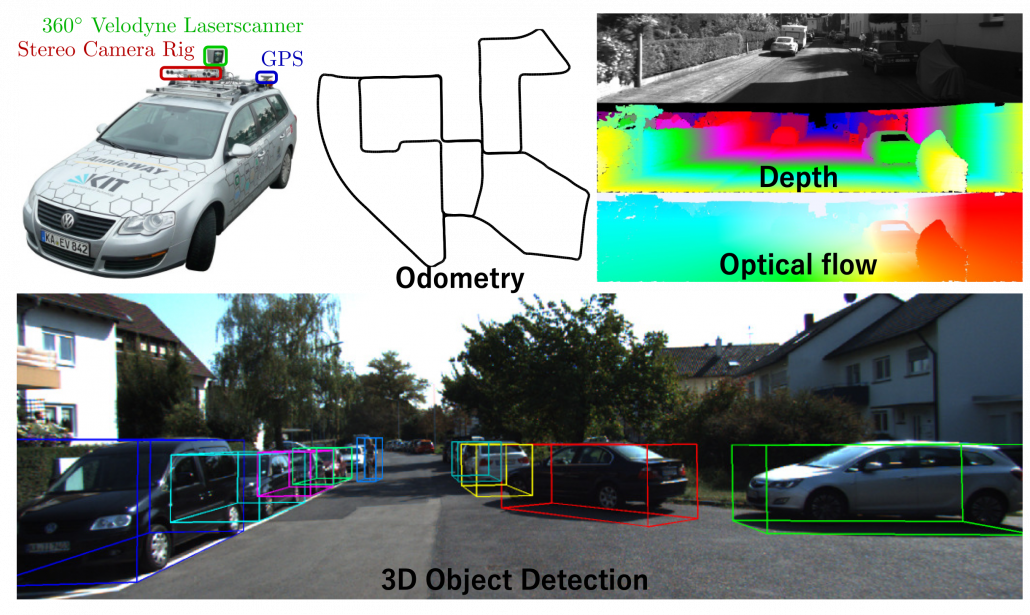
Next let’s see cases of data shortage. You should also keep it in mind that there are also several types of situations of data shortage. In fact there are cases where certain labels are supposed to be scarce such as classifications of imbalanced data, for example anomaly detection, judging spam mails, or medical examination. In those problems only some percent of data are classified as “errors,” “spam,” or “disease,” and others are classified as “normal.” Just keeping classifying data into “normal” would give maybe more than 95% accuracy. But finding the rest some percent accurately is much more important. In this case model performances need to be evaluated with ROC curves, namely relations of true positives and false positives.
The next type is more related to cases assumed in transfer learning. Some data are in the first place very expensive to obtain. For example CT images have to be stored by special medical apparatuses as you know. And even if a lot of CT images are already obtained, annotating the images often needs professional skills, thus its annotations cost is high. Another case of high annotation cost is for example detection or segmentation of objects in images. Even if you can collect numerous images on the Internet, annotating bounding boxes or pixel-wise segments require a lot of time. Annotating around 1000 images for classification might be ok, but annotating them at a pixel level is really time consuming. If you have a tablet, I would like you to paint each segment of objects in a picture with different colors. And you should multiply the time spent by 80,000, as many as the training images needed for Mask R-CNN, a popular model for instance segmentation. As you can imagine, it is a huge tediou work. Even preparing some 50 labeled images for fine-tuning is paiful, and even annotations for computer vision tasks itself is also a field of deep learning.
*I would say medical image processing is a relatively popular field in CV with deep learning, and there are several famous datasets on this field.
4, An overview on ways for dealing with lack of labeled data
I am going to first roughly introduce what kind of approaches can be taken to deal with lack of labeled data or data itself, but you should also keep it in mind that they are not clearly separated. Just as I am going to explain, one type of techniques can easily shift to another type. You should flexibly switch among them depending on your situations. And also please keep it in mind that these are well-studied areas, and tons of ingenious papers are announced one after another, usually giving slight changes in their performances. Problems I point out about each technique might not be a problem anymore with recently published researches on researches currently peer-read. It is hard to prove that something does not exist. Given those points, I think it is convenient to classify technique of dealing with label or data shortage as below.

Through this article, ideas of domains are important. A domain simply means a combination of a dataset and a task with it. Transfer learning is a family of machine learning techniques to make uses of knowledge learned in a domain to another domain, and the former is called a source domain, the latter a target domain. And discrepancies between a source domain and a target domain is called a domain shift. The figure below abstractly visualize examples of domains and domain shifts. Intuitively it is easy to imagine that face a CV task and an NLP task have bigger domain shifts than domains of leaf images taken from different angles, but quantitatively evaluating domain shifts is in practice hard, and I am not going to introduce the topic because that will need a lot of mathematics.

Instead of formulating transfer learning, I would like to take learning languages as an intuitive example of transfer learning. Most people master at least one native language before learning another one. Baby brains are a kind of fantastic machine learning models, and after overcoming many obstacles they master native languages. And people take advantages of their mother tongues to learn another language. Usually they learn foreign languages by comparing structures of translated sentences. And naturally, if both a foreign language and your language have analogies like grammatical cases or genders in common, language learning would be easy. In other words, proficiency in one language is helpful in leaning some language. But it is also possible that your native language badly affects learning the second language, due to grammatical structures, pronunciations. The case of a source domain deteriorating performances in a target domain is called negative transfer and contexts of transfer learning.
*I know similarities languages are not the sole and definite barometers of effectiveness in learning foreign languages. Sizes of economy or markets in a country would also affects English language acquisition of people there. But at least it is unfair to compare for example German or Dutch people learning English with Japanese, Chinese people learning it. Unlike Eastern Asian people who have to learn thousands of characters to at least read decent texts or who use very different grammars, European people obviously can use “transfer learning” to learn English.
5, Increasing training data
When you lack data or labels, the most straightforward and often quick solution is to just increase data. The two topics I will cover in this section are mainly conducted in one domain.
Data augmentation
Data augmentation is one of the first techniques you would learn to mitigate overfitting of machine learning, which is in short caused by lack of data. The idea is very simple and it is implemented well in deep learning libraries, so I would only briefly talk about it here. The idea of data augmentation is simply transforming input data by for example flipping, rotating, zooming, changing colors. By doing so for example an input image ![]() of a butterfly below with a label of
of a butterfly below with a label of ![]() can be converted to more than 6 images. This corresponds to getting a converted
can be converted to more than 6 images. This corresponds to getting a converted ![]() in the machine learning outline in the last section. And this process is the same as increasing the size of a dataet
in the machine learning outline in the last section. And this process is the same as increasing the size of a dataet ![]() . And one point you have to be careful is, you must not change
. And one point you have to be careful is, you must not change ![]() too much to change corresponding
too much to change corresponding ![]() . For example if
. For example if ![]() is distorted too much, it cannot be recognized as
is distorted too much, it cannot be recognized as ![]() anymore even by humans. Or if you rotate an image of a digit 6 180 degrees, its becomes 9. Recent researches focus on automatically find what kind of data augmentation is effective by using for example reinforcement learning.
anymore even by humans. Or if you rotate an image of a digit 6 180 degrees, its becomes 9. Recent researches focus on automatically find what kind of data augmentation is effective by using for example reinforcement learning.
 Here let me take an example of data augmentation technique that would be contrary to your intuition. A technique named mixup literally mix up data with different classes and their labels. In classification problems, labels are expressed as one-hot vectors, that is only an element corresponding to a correct element is
Here let me take an example of data augmentation technique that would be contrary to your intuition. A technique named mixup literally mix up data with different classes and their labels. In classification problems, labels are expressed as one-hot vectors, that is only an element corresponding to a correct element is ![]() and the others are
and the others are ![]() . In a case of binary dog-or-cat classification, each label is
. In a case of binary dog-or-cat classification, each label is ![]() or
or ![]() , respectively. In data augmentation, distorting data too much is a taboo because label data is contaminated, but in mixup you literally mix up labels. Randomly choosing a two inputs
, respectively. In data augmentation, distorting data too much is a taboo because label data is contaminated, but in mixup you literally mix up labels. Randomly choosing a two inputs ![]() and a number
and a number ![]() , you prepare a input and label pair
, you prepare a input and label pair ![]() . The figure below is an example of a mixing up a cat input and a dog input, and corresponding labels. It is known augmenting training data like this improves classification performances. It is said this is partly due to machine learning models effectively learning decision boundaries. In classification ambiguous inputs are bottlenecks, so learning to giving ambiguous outputs to ambiguous inputs can enhance classification abilities.
. The figure below is an example of a mixing up a cat input and a dog input, and corresponding labels. It is known augmenting training data like this improves classification performances. It is said this is partly due to machine learning models effectively learning decision boundaries. In classification ambiguous inputs are bottlenecks, so learning to giving ambiguous outputs to ambiguous inputs can enhance classification abilities.
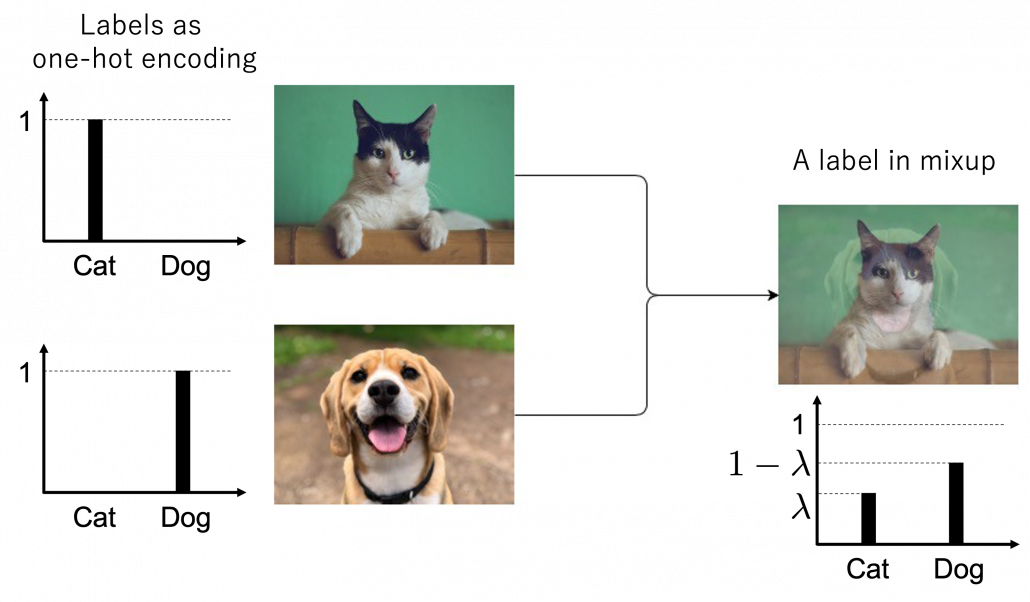
*One-hot-encoded labels are called hard labels, and otherwise soft labels. Recent topics in deep learning, such as lottery hypothesis, knowledge distillation, imply that whether supervising labels are hard or not is important in deep learning. Hopefully I would like to explain why little by little in my articles.
6, Active learning
Active learning is about how to annotate data and get labeled data efficiently. Labels of data do not equally contribute to enhancing machine learning models, and labels actually have qualities. Even if you give apparently similar images with the same label to machine learning models during training, the models cannot learn so much from the pair of data. You need to efficiently dig data to know its distribution by giving labels to samples. I think a good metaphor is geological survey by excavating with some boring. In order to know substances or features of ground, some earth need to be sampled with boring. But you cannot freely penetrate everywhere mainly due to costs. They need to be sampled one by one due to uncertainty about the ground.
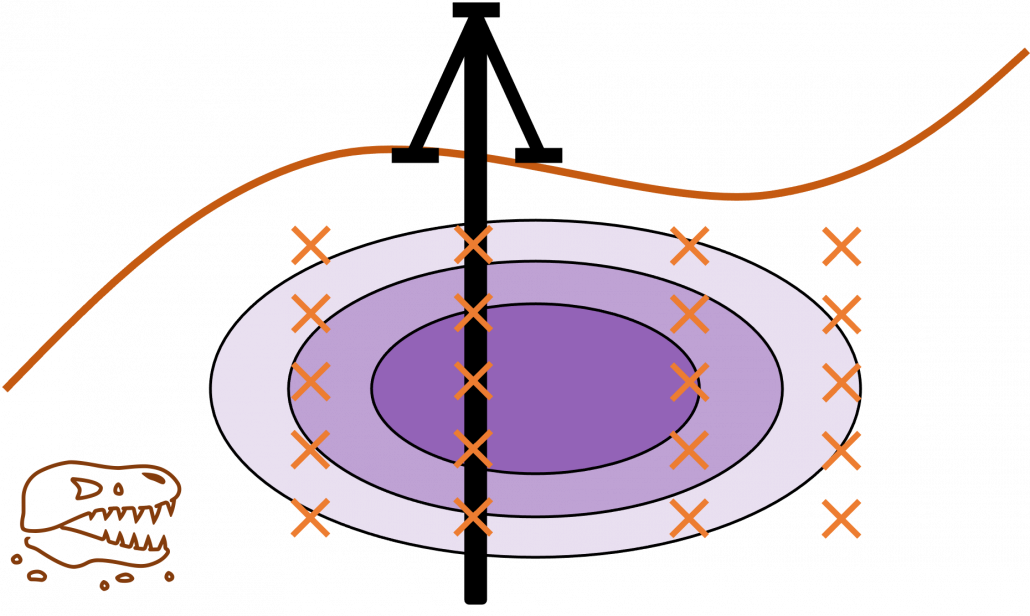
Similar approaches are often taken in machine learning or statistics, that is estimating distributions of data with a small size of samples is an important idea. A basic idea for doing that is you sample or annotate data which decreases uncertainty of your model the most. The figure simply exhibits the idea. We want to regress a data distribution with the red curve, and the cross marks can be sampled from the distribution. And the part filled with light blue shows uncertainty of the model to predict a value of ![]() for a
for a ![]() . When you want to regress the data with as few samples as possible, data points should be sampled from the parts with great uncertainties. And by doing so, you can see that the data is regressed efficiently with few samples.
. When you want to regress the data with as few samples as possible, data points should be sampled from the parts with great uncertainties. And by doing so, you can see that the data is regressed efficiently with few samples.
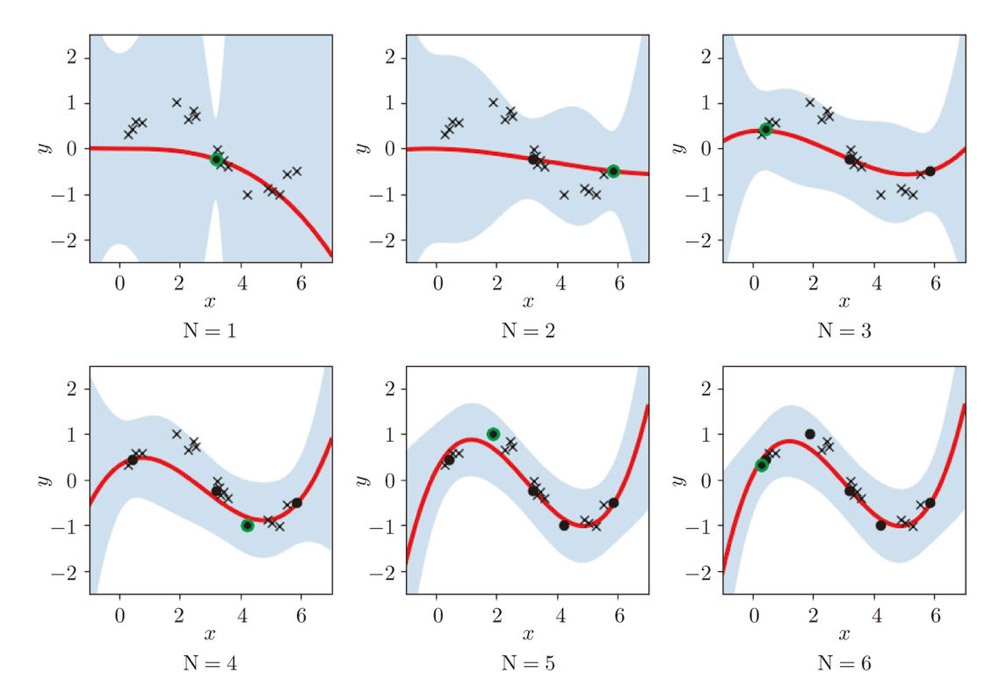
We have seen that modeling uncertainty is the key to active learning, and that can be applied to annotations of data in deep learning. An example of the process is displayed below, and in this case a deep neural network model (DNN model) is trained with some labeled data, and you give some signals for data annotations based on uncertainty of outputs of DNN models. And human annotators prioritize giving labels to the data. Such uncertainly can be estimated by using entropy of outputs or modeling data distributions.
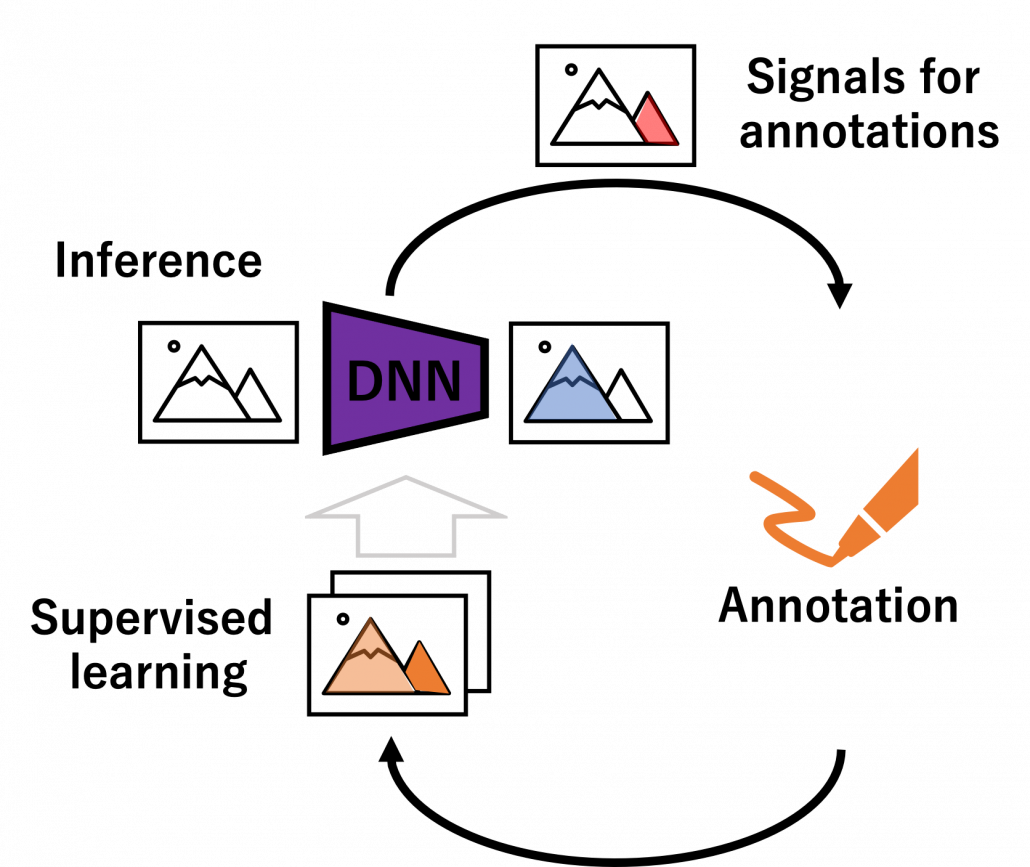
But when you get a certain amount of labels, the situation will be the same as semi-supervised learning, which I will explain next. That is, you might be already able to make the most of the labels so far with the help of unlabeled data. You should consider stopping labeling and start labeling depending on situations. And importantly, starting naively annotating data might become a quick solution rather than thinking about how to make uses of limited labels if extracting data itself is easy and does not cost so much. “Shut up and annotate!” could be often the best practice in practice. And annotations would be an effective way for exploratory data analysis (EDA), so I recommend you to immediately start annotating about 10 random samples at any rate.
7, Dealing with lack of labels in a single domain
In many cases, data themselves are easily available, and only annotations costs matter. The following two topics consider such cases, and again only one domain is considered. But by the end of this article you would see that other techniques covered in this article have a lot of analogies with topics introduced here.
Semi-supervised learning
Semi-supervised learning is a type of supervised learning where only limited labels are available in one domain. This is important in because many of other techniques in this article can be seen as semi-supervised learning from certain points of views. The figure below shows an intuition on semi-supervised learning in a case of classification task. In this case, original data distribution have two clusters of circles and triangles and a clear border can be drawn between them. But only with limited labeled data, decision boundaries would be ambiguous. However in fact, with a help of unlabeled data in dotted lines, machine learning model might be able to recognize two clusters with a help of unlabeled data. In other words, unlabeled data help models learn distribution of data. this might be natural as clusters of data can be estimated with unsupervised learning.
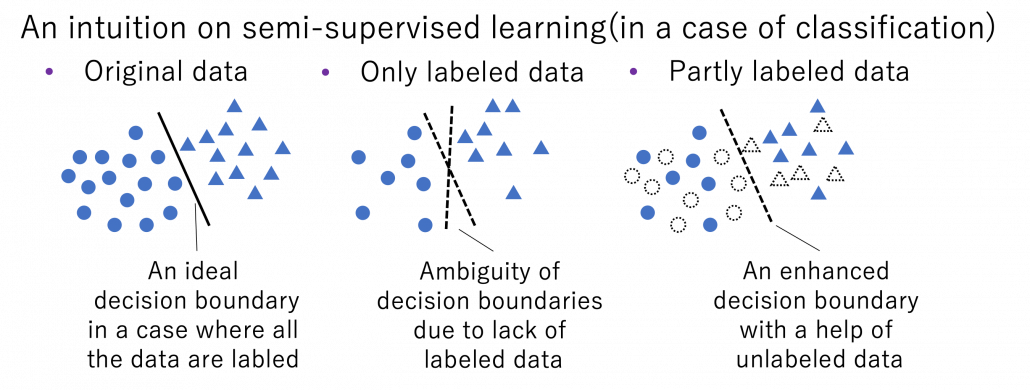
*As I have already mentioned, active learning could soon shift to semi-supervised learning, and it might be worth trying it before finishing labeling. But suspending labeling and resuming it later might not be efficient. At any rate you need to be flexible depending on situations.
Semi-supervised learning is applicable to several tasks, not only classification. I explained that normal supervised learning is adjusting parameters ![]() of a model
of a model ![]() so that it minimize loss function
so that it minimize loss function ![]() for a labeled dataset
for a labeled dataset ![]() . In semi-supervised learning, we assume that usually a bigger unsupervised dataset
. In semi-supervised learning, we assume that usually a bigger unsupervised dataset ![]() is available in the same domain. And semi-supervised learning optimize
is available in the same domain. And semi-supervised learning optimize ![]() by jointly minimizing
by jointly minimizing ![]() after designing a loss function
after designing a loss function ![]() for the unlabeled dataset. There are following 3 major ways of semi-supervised learning depending on how you design a
for the unlabeled dataset. There are following 3 major ways of semi-supervised learning depending on how you design a ![]() .
.
- Consistency regularization: adding slight changes to data
 in
in  and get
and get  . And training
. And training  so that
so that  and
and  give out a consistent output.
give out a consistent output. - Pseudo label: after training
 with
with  , using some estimations
, using some estimations  as labels of
as labels of  .
. - Entropy minimization: encouraging outputs
 to have smaller entropy.
to have smaller entropy.
More or less similar ideas show up in different transfer learning techniques, so it would be effective to learn the three semi-supervised learning ideas above.
Self-supervised learning
Self-supervised learning is often counted as unsupervised learning. Both unsupervised and self-supervised learning do not need label data, but especially when labels generated by processing themselves, that is often called self-supervised learning. A representative case of using self-supervised learning is auto-encoder. Simpler labels can be generated from input data themselves with elementary data processing. For example in a case of image processing, by rotating an input image 0, 90, 180, 270 degrees respectively, a classification task of estimating rotation degrees can be made. Another case is estimating the original input image after some simple image processing (for example colorization). These simple tasks generated solely from an input is called pretext task. And in a case of image processing, deep learning models can be prompted to learn image features .

Source: https://atcold.github.io/pytorch-Deep-Learning/en/week10/10-1/
Pretext tasks are applicable also to other fields for example NLP. A very simple task is hiding a part of an input sentence, and let neural networks estimate the blank word. And this is a basic idea of how to train BERTs, famous pre-trained NLP models. BERT models are trained this way with a huge and very general corpus without any specific topics. By doing so BERT model can already learn to detect some clusters of meanings in texts, as I visualize in the next section. But if you fine-tune BERT models with labeled texts with very specific topics, that often fails to achieve satisfying performance. In that case, the BERT models have to “get used to” the new dataset. In that case, BERT can “get used to” the new dataset by applying self-supervised learning on the new dataset. This tutorial of Huggingface demonstrates this with an example of adjusting a BERT model trained with Wikipedia to the IMDb dataset.

In the case above, the BERT model is fine-tuned with relatively lots of unlabeled data and after that trained with fewer labels. As a whole this can be seen as semi-supervised learning ,with fewer labels of the IMBb dataset and more unlabeled data. Also the ideas of pretext tasks, which prompt models to give consistent outputs given preprocessed inputs, have some analogies with consistency regularization in semi-supervised learning.
*The Huggingface tutorial says, they fine-tune a pre-trained BERT model trained in a self-supervised way to adjus it, and they call it “domain adaptation.” As you can see from the statement, distinctions of topics covered in this article can be just ambiguous.
8, Dealing with lack of data or labels over several domains
Another approach for tackling label or data shortage is taking advantages of other domains, which are usually larger and have enough labels. And such techniques is called transfer learning as I mentioned. It seems like transfer learning in business refers to “fine-tuning” explained below, but in academic contexts it is often also said transfer learning is almost synonym to “domain adaptation.” At any rate, my point is it would be more important to have comprehensive view on the techniques rather than clearly distinguishing them.
Fine tuning
Fine tuning would be the easiest way of transfer learning, and at the same time it is very powerful. Even though I am going to introduce other technique of transfer learning, more often than not it turns out that fine tuning can compensate them. Here I will only explain what it is like to use fine-tuning. I would say using fine-tuning is easy like using instant coffee. Conventionally you needed to train your original model with your own data, and that is very affected by sizes of data you have. I would say, that was like making coffee or coffee cakes from coffee you made from beans. But by using pre-trained models already trained somewhere with huge datasets, you can use models which can already more or less recognize data. The idea was very normal already in the field of CV, and NLP got the same idea with the advent of BERT, or already with word embeddings. That is like people learned to use instant coffee instead of roasting and brewing coffee every time.
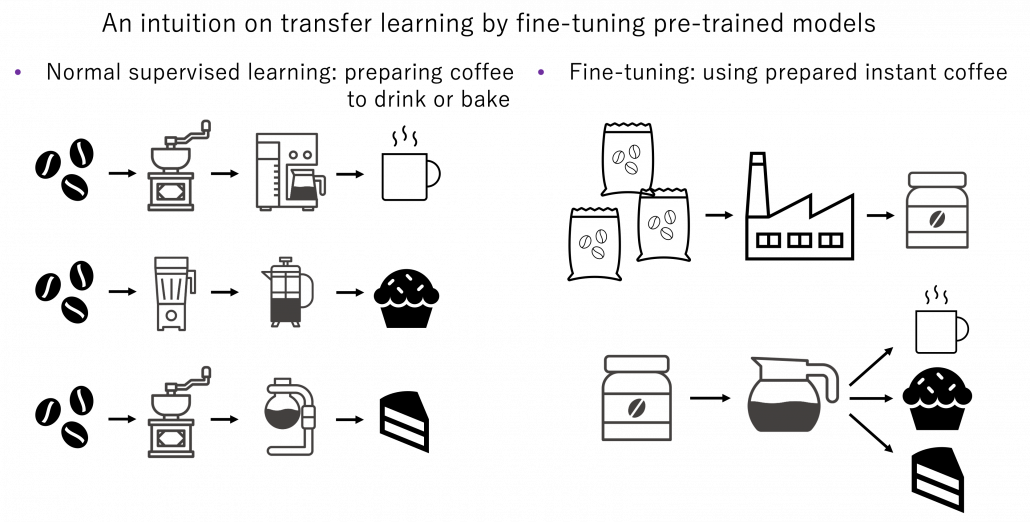
How such instant coffee is made depends on which type of deep learning is used on a huge dataset. Backbone CNN is usually trained on ImageNet dataset with supervised learning of a classification task. In case of BERT, it is trained with a huge corpus with a pretext task of estimating blank words of input sentences, which is classified to self-supervised learning. Let me more practically what the “coffee syrup” means. Machine learning is at any rate just mapping of tensors or vectors. In CV, an input images as a tensor is converted into a a vector or a tensor, and tasks like image classification are conducted with the converted tensor or vector. In case of an NLP task, usually a sequence of vectors is converted to a vector or another sequence of vectors. And these resulting tensors of vectors from models are the very “coffee syrup” I am talking about. An important point is, fine-tuning also considers transfer learning between different tasks. Backbone CNNs are usually trained with classification, BERT with self-supervised learning, but the there are a variety of final tasks. They are called downstream tasks. In other words, you don’t necessarily drink instant coffee as coffee.
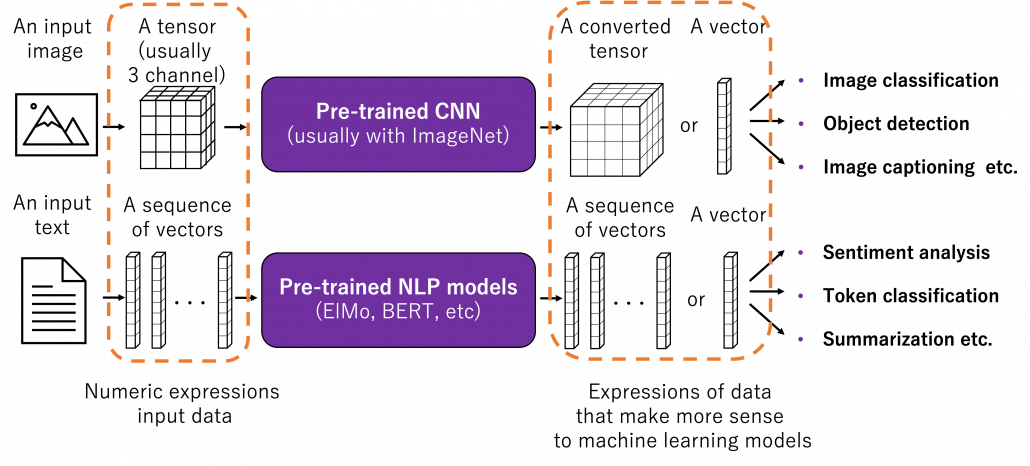
The two figures below are visualizations what the “instant coffee syrup” means. I processed random ![]() images in a dataset with a pre-trained backbone CNN, and I got corresponding
images in a dataset with a pre-trained backbone CNN, and I got corresponding ![]() dimensional vectors, that is a
dimensional vectors, that is a ![]() tensor. And I applied t-SNE to reduce its dimension from
tensor. And I applied t-SNE to reduce its dimension from ![]() to
to ![]() and got a
and got a ![]() tensor. The figure below shows arrangements of input images in the 2 dimensional space. As you can see, semantically similar images get closer.
tensor. The figure below shows arrangements of input images in the 2 dimensional space. As you can see, semantically similar images get closer.

Just as well, if you process random texts with BERT and apply a dimension reduction, you get a visualization like below. As well as the figure above, texts in similar topic get closer.
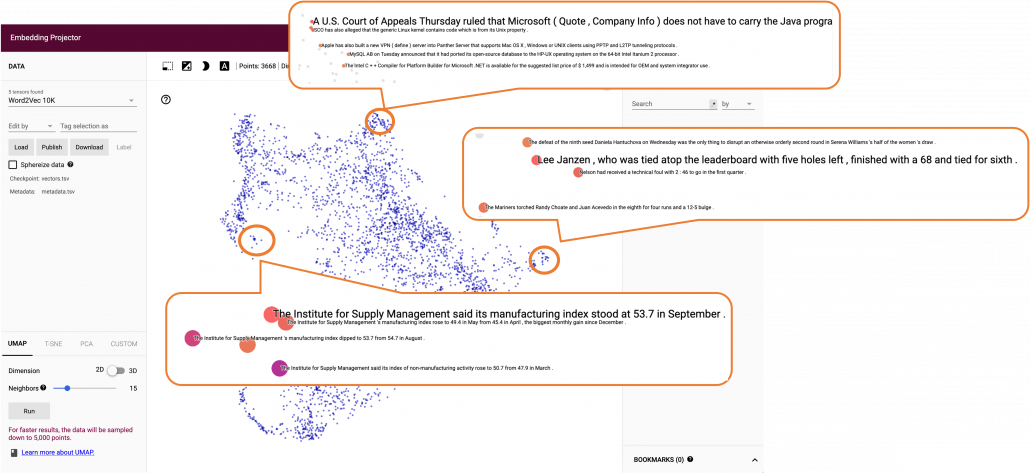
To make it catchy I expressed them as “coffee syrup” but this is a kind of how so-called AI sees data. Images and texts are just vectors or tensors on computer, and AI process another set of tensors of vectors in spaces which make sense to them.
Fine-tuning is quite easy. You have only to train a pre-trained model you downloaded just like normal supervised learning with your dataset. And when you train CV models with backbone CNN, the backbone is almost automatically downloaded. You have to be careful about some points, for example you have to set learning rate smaller. Let me avoid too detailed points in this article. Hopefully in the future, I’d like to write about more practical fine-tuning tips.
Domain adaptation
Domain adaptation is another family of techniques to make uses of knowledge gained in one domain in another domain. Domain adaptation is a Domain adaptation is these days often used as almost a synonym of transfer learning. But papers on domain adaptation usually assume to handle the same tasks both in a source and a target domain. So I would say domain adaptation is a subfield of transfer learning. Domain adaptation is more of how to tackle deterioration of machine learning performances when trained models are applied in different domains. Based on how much labels are available in each domain, domain adaptation is classified to several types. And unsupervised domain adaptation (UDA), where labels are available only in a source domain, is considered as the most challenging and studied well.
*Another explanation I often hear about domain adaptation is, when a models trained on a dataset is trained on another data, domain adaptation can be used to mitigate decreases in performance. I think in this context, performance of the model on the source domain is not discussed. When you apply some retraining with a new dataset, performance of the model on the source domain often drastically decrease. This is called catastrophic forgetting, and techniques like continuous learning are studied to tackle this problem. I have not really seen continuous learning in contexts of domain adaptation, but I thin these are related.
There several approaches in domain adaptation, and one frequently used approach is using adversarial loss. As we saw with the example of getting “coffee syrup,” data is first mapped into a certain space, and this is often called feature extraction. And outputs with the feature extractor are processed are processed more to give task-specific results with some networks. Often in domain adaptation, we put a domain discriminator network right after the feature extractor. And the domain discriminator classifies whether the features extracted come from the source or target domain. The feature extractor tries to extract features the domain have in common, and the domain discriminator tries to distinguish them, and two networks compete. In this way, the feature extractor and the domain discriminator form generative adversarial network (GAN), and the feature extractor learns to extract features that are hard to distinguish their domains. Feature extractor is trained so that it extract domain invariant features, for example edges and silhouette.

As well as in other transfer learning techniques, one ultimate goal of UDA is training a deep learning model only with synthetic labeled data, for example CGI, and apply the model on a totally unlabeled dataset. Converting a source domain to look like a target domain with Cycle GAN is an often used approach in domain adaptation. In domain adaptation a source domain is supposed to be easier to annotate. The figure below is an example of converting a black and white cell images to colored images.
*You could easily try converting data with Cycle GAN by preparing two datasets, and I made the converted data by myself. But you need at least one GPU to try that.

However some people insist that usefulness of UDA is very questionable. In the first place, if you do not have any labels on the target domain, that means you cannot evaluate anything qualitatively on the dataset of interest. And if you can prepare some of evaluation data or labels, applying other techniques like fine-tuning might be enough.
Meta learning and few-shot learning
One simple way to explain meta learning is that, it is a machine learning technique teach models to learn efficiently. We can also say that it is a transfer learning case where target domains are unknown. A famous meta learning method is Model-Agnostic Meta-Learning (MAML). MAML is used to get an ideal parameter ![]() which can be quickly and effectively used to new tasks. Like in the figure below,
which can be quickly and effectively used to new tasks. Like in the figure below, ![]() reaches the generally convenient parameter shown as the black dot. And the parameter can quickly reach the parameters
reaches the generally convenient parameter shown as the black dot. And the parameter can quickly reach the parameters ![]() , which effective for each task.
, which effective for each task. 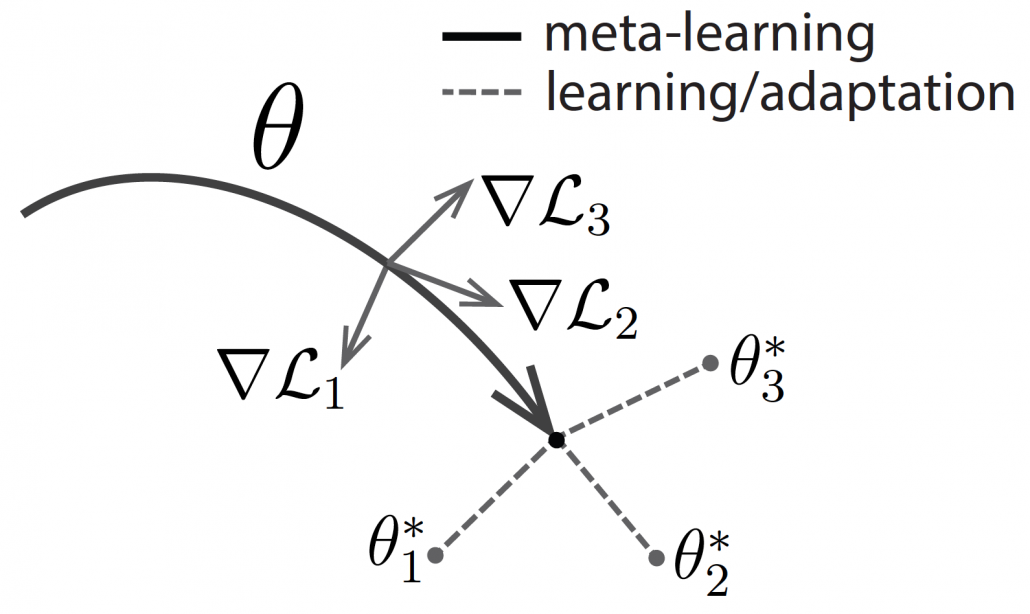
Another interesting application of meta learning is few-shot learning. Few-shot learning trains a classification model to learn to acquire classification ability based only on a very few samples. By letting the models learn classification tasks over many episodes, the model learn comes to learn efficiently from limited data samples at a test phase. The figure below shows a case of few-shot learning, where a model learns some episodes of 3-class classifications with only 4 samples per class. Few-shot learning attempts to enable human-level flexibility of perception. MAML is known to be effective also for few-shot learning.

However, studies these days do also show that fine tuning pre-trained models with a few sample data show competitive results to those by few-shot learning. Similar things can be said about large language models like GPT. Chat GPT or GPT-3/GPT-4 for example can be fine-tuned with small extra training samples, and the logic behind is different from meta learning. Fine-tuning pre-trained models rather might be closer to human learning. Humans can effectively learn new topics based on what they have experienced so far. Thus again here, fine-tuning models can be an easier and realistic solution.
I have explained an overview of machine learning techniques for handling lack of data, and as you might have noticed, fine-tuning models could be enough in many cases. I am not sure how much other transfer learning technique would be widely as useful as fine-tuning at a business level. At least, I hope this article would be a rough guideline for machine learning tasks with small sizes of data or labels. And if you have a chance to work on very unique data with very few labels, you wouldn’t be able to rely so much on only naive fine tuning of pre-trained models. In that case, you tasks have your own problem, and you would have to be careful about your EDA, data cleaning, and labeling. In that case you should consider some techniques introduced here. Hopefully someday I would like to write more detailed tutorials with each transfer learning technique. And I hope you would be able to apply a variety of transfer learning locally, not only relying on huge resources of gigantic entities. And that would lead to a more secure future, I guess.
Interview – Daten vermarkten, nicht verkaufen!
/in Artificial Intelligence, Big Data, Data Science, Insights, Interviews, Main Category/by RedaktionDas Format Business Talk am Kudamm in Berlin führte ein Interview mit Benjamin Aunkofer zu den Themen “Daten vermarkten, nicht verkaufen!”.
In dem Interview erklärt Benjamin Aunkofer, warum der Datenschutz für die meisten Anwendungsfälle keine Rolle spielt und wie Unternehmen mit Data as a Service oder AI as a Service Ihre Daten zu Geld machen, selbst dann, wenn diese Daten nicht herausgegeben werden können.
Nachfolgend das Interview auf Youtube sowie die schriftliche Form zum Nachlesen:
Nachfolgend das Transkript zum Interview:
1 – Herr Aunkofer, Daten gelten als der wichtigste Rohstoff des 22. Jahrhunderts. Bei der Vermarktung datengestützter Dienstleistung tun sich deutsche Unternehmen im Vergleich zur Konkurrenz aus den USA oder Asien aber deutlich schwerer. Woran liegt das?
Ach da will ich keinen Hehl draus machen. Die Unterschiede liegen in den verschiedenen Kulturen begründet. In den USA herrscht in der Gesellschaft ein sehr freiheitlicher Gedanke, der wohl eher darauf hinausläuft, dass wer Daten sammelt, über diese dann eben auch weitgehend verfügt.
In Asien ist die Kultur eher kollektiv ausgerichtet, um den Einzelnen geht es dort ja eher nicht so.
In Deutschland herrscht auch ein freiheitlicher Gedanke – Gott sei Dank – jedoch eher um den Schutz der personenbezogenen Daten.
Das muss nun aber gar nicht schlimm sein. Zwar mag es in Deutschland etwas umständlicher und so einen Hauch langsamer sein, Daten nutzen zu dürfen. Bei vielen Anwendungsfällen kann man jedoch sehr gut mit korrekt anonymisierten Massendaten arbeiten und bei gesellschaftsfördernen Anwendungsfällen, man denke z. B. an medizinische Vorhersagen von Diagnosen oder Behandlungserfolgen oder aber auch bei der Optimierung des öffentlichen Verkehrs, sind ja viele Menschen durchaus bereit, ihre Daten zu teilen.
Gesellschaftlichen Nutzen haben wir aber auch im B2B Geschäft, bei dem wir in Unternehmen und Institutionen die Prozesse kundenorientierter und schneller machen, Maschinen ausfallsicherer machen usw.. Da haben wir meistens sogar mit gar keinen personenbezogenen Daten zu tun.
2 – Sind die Bedenken im Zusammenhang mit Datenschutz und dem Schutz von Geschäftsgeheimnissen nicht berechtigt?
Also mit Datenschutz ist ja der gesetzliche Datenschutz gemeint, der sich nur auf personenbezogene Daten bezieht. Für Anwendungsfälle z. B. im Customer Analytics, also da, wo man Kundendaten analysieren möchte, geht das nur über die direkte Einwilligung oder eben durch anonymisierte Massendaten. Bei betrieblicher Prozessoptimierung, Anlagenoptimierung hat man mit personenbezogenen Daten aber fast nicht zu tun bzw. kann diese einfach vorher wegfiltern.
Ein ganz anderes Thema ist die Datensicherheit. Diese schließt die Sicherheit von personenbezogenen Daten mit ein, betrifft aber auch interne betriebliche Angelegenheiten, so wie etwas Lieferanten, Verträge, Preise… vielleicht Produktions- und Maschinendaten, natürlich auch Konstruktionsdaten in der Industrie.
Dieser Schutz ist jedoch einfach zu gewährleisten, wenn man einige Prinzipien der Datensicherheit verfolgt. Wir haben dafür Checklisten, quasi wie in der Luftfahrt. Bevor der Flieger abhebt, gehen wir die Checks durch… da stehen so Sachen drauf wie Passwortsicherheit, Identity Management, Zero Trust, Hybrid Cloud usw.
3 – Das Rückgrat der deutschen Wirtschaft sind die vielen hochspezialisierten KMU. Warum sollte sich beispielsweise ein Maschinenbauer darüber Gedanken machen, datengestützte Geschäftsmodelle zu entwickeln?
Nun da möchte ich dringend betonen, dass das nicht nur für Maschinenbauer gilt, aber es stimmt schon, dass Unternehmen im Maschinenbau, in der Automatisierungstechnik und natürlich der Werkzeugmaschinen richtig viel Potenzial haben, ihre Geschäftsmodelle mit Daten auszubauen oder sogar Datenbestände aufzubauen, die dann auch vermarktet werden können, und das so, dass diese Daten das Unternehmen gar nicht verlassen und dabei geheim bleiben.
4 – Daten verkaufen, ohne diese quasi zu verkaufen? Wie kann das funktionieren?
Das verrate ich gleich, aber reden wir vielleicht kurz einmal über das Verkaufen von Daten, die man sogar gerne verkauft. Das Verkaufen von Daten ist nämlich gerade so ein Trend. Das Konzept dafür heißt Data as a Service und bezieht sich dabei auf öffentliche Daten aus Quellen der Kategorie Open Data und Public Data. Diese Daten können aus dem Internet quasi gesammelt, als Datenbasis dann im Unternehmen aufgebaut werden und haben durch die Zusammenführung, Bereinigung und Aufbereitung einen Wert, der in die Millionen gehen kann. Denn andere Unternehmen brauchen vielleicht auch diese Daten, wollen aber nicht mehr warten, bis sie diese selbst aufbauen. Beispiele dafür sind Daten über den öffentlichen Verkehr, Infrastruktur, Marktpreise oder wir erheben z. B. für einen Industriekonzern Wasserqualitätsdaten beinahe weltweit aus den vielen vielen regionalen Veröffentlichungen der Daten über das Trinkwasser. Das sind zwar hohe Aufwände, aber der Wert der zusammengetragenen Daten ist ebenfalls enorm und kann an andere Unternehmen weiterverkauft werden. Und nur an jene Unternehmen, an die man das eben zu tun bereit ist.
5 – Okay, das sind öffentliche Daten, die von Unternehmen nutzbar gemacht werden. Aber wie ist es nun mit Daten aus internen Prozessen?
Interne Daten sind Geschäftsgeheimnisse und dürfen keinesfalls an Dritte weitergegeben werden. Dazu gehören beispielsweise im Handel die Umsatzkurven für bestimmte Produktkategorien sowie aber auch die Retouren und andere Muster des Kundenverhaltens, z. B. die Reaktion auf die Konfiguration von Online-Marketingkampagnen. Die Unternehmen möchten daraus jedoch Vorhersagemodelle oder auch komplexere Anomalie-Erkennung auf diese Daten trainieren, um sie für sich in ihren operativen Prozessen nutzbar zu machen. Machine Learning, übrigens ein Teilgebiet der KI (Künstlichen Intelligenz), funktioniert ja so, dass man zwei Algorithmen hat. Der erste Algorithmus ist ein Lern-Algorithmus. Diesen muss man richtig parametrisieren und überhaupt erstmal den richtigen auswählen, es gibt nämlich viele zur Auswahl und ja, die sind auch miteinander kombinierbar, um gegenseitige Schwächen auszugleichen und in eine Stärke zu verwandeln. Der Lernalgorithmus erstellt dann, über das Training mit den Daten, ein Vorhersagemodell, im Grunde eine Formel. Das ist dann der zweite Algorithmus. Dieser Algorithmus entstand aus den Daten und reflektiert auch das in den Daten eingelagerte Wissen, kanalisiert als Vorhersagemodell. Und dieses kann dann nicht nur intern genutzt werden, sondern auch anderen Unternehmen zur Nutzung zur Verfügung gestellt werden.
6 – Welche Arten von Problemen sind denn geeignet, um aus Daten ein neues Geschäftsmodell entwickeln zu können?
Alle operativen Geschäftsprozesse und deren Unterformen, also z. B. Handels-, Finanz-, Produktions- oder Logistikprozesse generieren haufenweise Daten. Das Problem für ein Unternehmen wie meines ist ja, dass wir zwar Analysemethodik kennen, aber keine Daten. Die Daten sind quasi wie der Inhalt einer Flasche oder eines Ballons, und der Inhalt bestimmt die Form mit. Unternehmen mit vielen operativen Prozessen haben genau diese Datenmengen.Ein Anwendungsfallgebiet sind z. B. Diagnosen. Das können neben medizinischen Diagnosen für Menschen auch ganz andere Diagnosen sein, z. B. über den Zustand einer Maschine, eines Prozesses oder eines ganzen Unternehmens. Die Einsatzgebiete reichen von der medizinischen Diagnose bis hin zu der Diagnose einer Prozesseffizienz oder eines Zustandes in der Wirtschaftsprüfung.Eine andere Kategorie von Anwendungsfällen sind die Prädiktionen durch Text- oder Bild-Erkennung. In der Versicherungsindustrie oder in der Immobilienbranche B. gibt es das Geschäftsmodell, dass KI-Modelle mit Dokumenten trainiert werden, so dass diese automatisiert, maschinell ausgelesen werden können. Die KI lernt dadurch, welche Textstellen im Dokument oder welche Objekte im Bild eine Rolle spielen und verwandelt diese in klare Aussagen.
Die Industrie benutzt KI zur generellen Objekterkennung z. B. in der Qualitätsprüfung. Hersteller von landwirtschaftlichen Maschinen trainieren KI, um Unkraut über auf Videobildern zu erkennen. Oder ein Algorithmus, der gelernt hat, wie Ultraschalldaten von Mirkochips zu interpretieren sind, um daraus Beschädigungen zu erkennen, so als Beispiel, den kann man weiterverkaufen.
Das Verkaufen erfolgt dabei idealerweise hinter einer technischen Wand, abgeschirmt über eine API. Eine API ist eine Schnittstelle, über die man die KI verwenden kann. Daraus wird dann AI as a Service, also KI als ein Service, den man Dritten gegen Bezahlung nutzen lassen kann.
7 – Gehen wir mal in die Praxis: Wie lassen sich aus erhobenen Daten Modelle entwickeln, die intern genutzt oder als Datenmodell an Kunden verkauft werden können?
Zuerst müssen wir die Idee natürlich richtig auseinander nehmen. Nach einer kurzen Euphorie-Phase, wie toll die Idee ist, kommt ja dann oft die Ernüchterung. Oft überwinden wir aber eben diese Ernüchterung und können starten. Der einzige Knackpunkt sind meistens fehlende Daten, denn ja, wir reden hier von großen Datenhistorien, die zum Einen überhaupt erstmal vorliegen müssen, zum anderen aber auch fast immer aufbereitet werden müssen.Wenn das erledigt ist, können wir den Algorithmus trainieren, ihn damit auf eine bestimmte Problemlösung sozusagen abrichten.Übrigens können Kunden oder Partner die KI selbst nachtrainieren, um sie für eigene besondere Zwecke besser vorzubereiten. Nehmen wir das einfache Beispiel mit der Unkrauterkennung via Bilddaten für landwirtschaftliche Maschinen. Nun sieht Unkraut in fernen Ländern sicherlich ähnlich, aber doch eben anders aus als hier in Mitteleuropa. Der Algorithmus kann jedoch nachtrainiert werden und sich der neuen Situation damit anpassen. Hierfür sind sehr viel weniger Daten nötig als es für das erstmalige Anlernen der Fall war.
8 – Viele Unternehmen haben Bedenken wegen des Zeitaufwands und der hohen Kosten für Spezialisten. Wie hoch ist denn der Zeit- und Kostenaufwand für die Implementierung solcher KI-Modelle in der Realität?
Das hängt sehr stark von der eigentlichen Aufgabenstellung ab, ob die Daten dafür bereits vorliegen oder erst noch generiert werden müssen und wie schnell das alles passieren soll. So ein Projekt dauert pauschal geschätzt gerne mal 5 bis 8 Monate bis zur ersten nutzbaren Version.
Sehen Sie die zwei anderen Video-Interviews von Benjamin Aunkofer:
How to speed up claims processing with automated car damage detection
/in Artificial Intelligence, Data Science, Deep Learning, Insights, Machine Learning, Main Category, Use Cases/by Benjamin AunkoferAI drives automation, not only in industrial production or for autonomous driving, but above all in dealing with bureaucracy. It is an realy enabler for lean management!
One example is the use of Deep Learning (as part of Artificial Intelligence) for image object detection. A car insurance company checks the amount of the damage by a damage report after car accidents. This process is actually performed by human professionals. With AI, we can partially automate this process using image data (photos of car damages). After an AI training with millions of photos in relation to real costs for repair or replacement, the cost estimation gets suprising accurate and supports the process in speed and quality.
AI drives automation and DATANOMIQ drives this automation with you! You can download the Infographic as PDF.
Download this Infographic as PDF now by clicking here!
We wrote this article in cooperation with pixolution, a company for computer vision and AI-bases visual search. Interested in introducing AI / Deep Learning to your organization? Do not hesitate to get in touch with us!
 DATANOMIQ is the independent consulting and service partner for business intelligence, process mining and data science. We are opening up the diverse possibilities offered by big data and artificial intelligence in all areas of the value chain. We rely on the best minds and the most comprehensive method and technology portfolio for the use of data for business optimization.
DATANOMIQ is the independent consulting and service partner for business intelligence, process mining and data science. We are opening up the diverse possibilities offered by big data and artificial intelligence in all areas of the value chain. We rely on the best minds and the most comprehensive method and technology portfolio for the use of data for business optimization.
Interview – Mehr Business-Nerds, bitte!
/in Artificial Intelligence, Data Science, Interviews/by Haufe AkademieDie Haufe Akademie im Gespräch mit Prof. Dr. Stephan Matzka, Hochschulprofessor an der HTW Berlin und Trainer der Haufe Akademie darüber, wie Data Science und KI verdaulich vermittelt werden können und was eigentlich passiert, wenn man es nicht tut.
Sie beschäftigen sich mit Data Science, Algorithmen und Machine Learning – Hand aufs Herz: Sind Sie ein Nerd, Herr Prof. Matzka?
Stephan Matzka: (lacht) Ich bin ein neugieriger Mensch und möchte gerne mehr über die Menschen und Dinge erfahren, die mich umgeben. Dafür benötige ich Informationen, die ich einordnen und bewerten kann und nichts anderes macht Data Science. Wenn Neugier also einen Nerd ausmacht, bin ich gerne ein Nerd.
Aber all die Buzzwords, die Sie gerade genannt haben, wie Machine Learning oder Algorithmen, blenden mehr als sie helfen. Ich spreche lieber von menschlicher und künstlicher Intelligenz. Deren Gemeinsamkeiten und Unterschiede sind gut zu erklären und dieses Verständnis ist der Schlüssel für alles Weitere.
Ist das Verständnis für Data Science und Machine Learning auch der Schlüssel für den Zukunftserfolg von Unternehmen oder wird die Businessrelevanz von Data Science überschätzt?
Stephan Matzka: Zunächst mal ist Machine Learning größtenteils einfach Statistik, die sehr clever angewandt wird. Damit wir Benutzer:innen nicht wie in der Schule mit der Hand rechnen müssen, gibt es Algorithmen, die uns die Arbeit abnehmen. Die Theorie ist also altbekannt. Aber die technischen Möglichkeiten haben sich geändert.
Sie können das mit Strom vergleichen, den gibt es schon länger. Aber erst mit einem Elektromotor können Sie Power auf die Straße bringen. Daten sind also altbekannte Rohstoffe, die Algorithmen und Rechenleistung von heute aber ein völlig neuer Motor.
Wenn Sie sehen, wie radikal die Dampfmaschine und der Elektromotor die Wirtschaft beeinflusst haben, dann gewinnen Sie einen Eindruck, was gerade im Bereich künstliche Intelligenz abgeht, und das über alle Unternehmensgrößen und Branchen hinweg.
So eine Dampfmaschine ist für viele wahrscheinlich deutlich einfacher zu greifen als das tech-lastige Universum Data Science. Das ist schon sehr abstrakt. Ist es so schwierig, wie es aussieht?
Stephan Matzka: Data Science kann man, wie alle Dinge im Leben, kompliziert oder einfach machen. Und es gibt auch auf diesem Feld Menschen, die Schwieriges einfach aussehen lassen. Das sind die Vorbilder, von denen wir alle lernen können.
Künstliche Intelligenz, oder kurz KI, bietet Menschen und Unternehmen große Chancen, wenn Sie sich rechtzeitig damit beschäftigen. Dabei geht es um nicht weniger als die Frage, ob wir in unserer Arbeitswelt zukünftig KI für uns arbeiten lassen oder abwarten, bis uns ein Algorithmus vorgibt, was wir als Nächstes tun sollen. Mit der richtigen Unterstützung ist der Aufwand jedoch überschaubar und der Nutzen für Unternehmen und Organisationen enorm.
Viele Mitarbeiter:innen hören nach „Wir sind jetzt agil“ neuerdings „Mach‘ mal KI“ – was raten Sie den Kolleg:innen und Entscheider:innen in mittelständischen Unternehmen für den Umgang mit dem Thema?
Stephan Matzka: Es braucht zum einen Impulse „von außen“, um sich mit diesem wichtigen Thema auseinanderzusetzen und einen Start zu finden. Und zum anderen braucht es Mitarbeiter:innen, die datenaffin sind, sich mit dem Thema bereits auseinandergesetzt haben und Use Cases entwickeln sowie hinterfragen können. Meine Berufserfahrung zeigt: Gerade am Anfang ist es noch sehr leicht, bei den klassischen „Low Hanging Fruits“ Erfolge zu erzielen. Das motiviert für das nächste Projekt und schon ist das Momentum im Unternehmen.
Was sind die Minimalanforderungen in einem Unternehmen, um mit Data Science und Machine Learning einen echten Mehrwert zu schaffen und die „Low Hanging Fruits“ zu ernten?
Stephan Matzka: Der Rohstoff sind Daten in digitaler Form, ob in Excel-Listen, in SAP oder einer Datenbank ist erst mal zweitrangig. Für die Auswertung brauchen Sie passende Software und Menschen, die diese Software bedienen können.
In jedem Unternehmen gibt es solche Daten, die Software ist häufig kostenlos, der eigentliche Engpass sind aktuell die Expert:innen.
Könnte ich mir nicht die Arbeit sparen und Beratungsunternehmen einsetzen?
Stephan Matzka: Das könnten Sie, und Beratungsunternehmen können Ihnen oft auch die richtigen Themen aufzeigen. Gleichzeitig wirft dies zwei wesentliche Fragen auf: Wie können Sie die Qualität und den Preis einer Lösung beurteilen, die Ihnen ein externer Dienstleister anbietet? Und zweitens, wie verankern Sie nachhaltig das Wissen in Ihrem Unternehmen?
Damit die Beratungsleistung Ihnen also wirklich weiterhilft, benötigen Sie Beurteilungskompetenz auf dem Gebiet der künstlichen Intelligenz im eigenen Unternehmen. Diese Beurteilungskompetenz im Businesskontext zu schaffen ist aus meiner Sicht ein wesentlicher Erfolgsfaktor für Unternehmen und sollte eher kurz- als mittelfristig angegangen werden.
Haufe Akademie: Nochmal zurück zu den Daten: Woher weiß ich, ob ich genug Daten habe? Sonst bilde ich jemanden aus oder stelle jemanden ein, der mich Geld kostet, aber nichts zu tun hat.
Stephan Matzka: Mit den Daten ist es ein wenig so wie mit den Finanzen, kann ich jemals „genug Budget“ im Unternehmen haben? Natürlich ist es mit großen Datenmengen leichter möglich, bessere Resultate zu erzielen, genauso wie mit mehr Projektbudget. Aber wir alle haben schon erlebt, wie kleine Projekte Erstaunliches bewegt haben und Großprojekte spektakulär gescheitert sind.
Genau wie Budgets sind Daten meist in dem Umfang vorhanden, in dem sie eben verfügbar sind. Die vorhandenen Daten klug zu nutzen: Das ist das Ziel.
Ein Beispiel aus der Praxis: Es gibt sehr große Firmen mit riesigen Datenmengen, die mir, nachdem ich bei ihnen einen Drucker gekauft habe, weiter Werbung für andere Drucker zeigen anstatt Werbung für passende Toner. So eine KI würde mir kein mittelständisches Unternehmen abnehmen.
Gleichzeitig werden Sie sich wundern, welches Wissen oft schon in einfachen Excel-Tabellen schlummert. Wissen Sie zum Beispiel, was Ihnen der höchste Umsatz eines Kunden in den letzten zwölf Monaten und die Zeitabstände der letzten drei Bestellungen schon jetzt über die nächste Bestellung verraten?
In meinen Recherchen zum Thema bin ich oft an hohen Einstiegshürden gescheitert. Trotzdem habe ich gespürt, dass das Thema wichtig ist. Das war mitunter frustrierend. Welche Fragen sollte ich mir als Mitarbeiter:in stellen, wenn ich mich für Data Science interessiere, aber keine Vorkenntnisse habe?
Stephan Matzka: Das Wichtigste ist erstmal, sich nicht abschrecken zu lassen. 80% der Themen lassen sich zum Beispiel komplett ohne Mathematik erklären. Nochmal 15% sind Stoff der Sekundarstufe, bleiben noch 5% übrig. Die haben es tatsächlich in sich und dann können Sie sich immer noch entscheiden: Finde ich das Thema so spannend (und habe ich die Zeit), dass ich mich auch da noch reinarbeite. Oder reichen mir die 95% Verständnis für die zuverlässige Lösung meiner Business-Fragestellungen aus. Viel entscheidender ist für mich, sich dem Thema mutig anzunehmen, die ersten Erfolge zu feiern und mit diesem Rückenwind die nächsten Schritte zu tun.
Vielen Dank für das Gespräch, Herr Prof. Matzka!
Alles dreht sich um Daten: die Trainingsmethoden des Deep Learning
/in Artificial Intelligence, Data Science, Deep Learning, Machine Learning, Main Category/by Benjamin AunkoferIm Deep Learning gibt es unterschiedliche Trainingsmethoden. Welche wir in einem KI Projekt anwenden, hängt von den zur Verfügung gestellten Daten des Kunden ab: wieviele Daten gibt es, sind diese gelabelt oder ungelabelt? Oder gibt es sowohl gelabelte als auch ungelabelte Daten?
Nehmen wir einmal an, unser Kunde benötigt für sein Tourismusportal strukturierte, gelabelte Bilder. Die Aufgabe für unser KI Modell ist es also, zu erkennen, ob es sich um ein Bild des Schlafzimmers, Badezimmers, des Spa-Bereichs, des Restaurants etc. handelt. Sehen wir uns die möglichen Trainingsmethoden einmal an.
1. Supervised Learning
Hat unser Kunde viele Bilder und sind diese alle gelabelt, so ist das ein seltener Glücksfall. Wir können dann das Supervised Learning anwenden. Dabei lernt das KI Modell die verschiedenen Bildkategorien anhand der gelabelten Bilder. Es bekommt für das Training von uns also die Trainingsdaten mit den gewünschten Ergebnissen geliefert.
Während des Trainings sucht das Modell nach Mustern in den Bildern, die mit den gewünschten Ergebnissen zusammenpassen. So erlernt es Merkmale der Kategorien. Das Gelernte kann das Modell dann auf neue, ungesehene Daten übertragen und auf diese Weise eine Vorhersage für ungelabelte Bilder liefern, also etwa “Badezimmer 98%”.
2. Unsupervised learning
Wenn unser Kunde viele Bilder als Trainingsdaten liefern kann, diese jedoch alle nicht gelabelt sind, müssen wir auf Unsupervised Learning zurückgreifen. Das bedeutet, dass wir dem Modell nicht sagen können, was es lernen soll (die Zuordnung zu Kategorien), sondern es muss selbst Regelmäßigkeiten in den Daten finden.
Eine aktuell gängige Methode des Unsupervised Learning ist Contrastive Learning. Dabei generieren wir jeweils aus einem Bild mehrere Ausschnitte. Das Modell soll lernen, dass die Ausschnitte des selben Bildes ähnlicher zueinander sind als zu denen anderer Bilder. Oder kurz gesagt, das Modell lernt zwischen ähnlichen und unähnlichen Bildern zu unterscheiden.
Über diese Methode können wir zwar Vorhersagen erzielen, jedoch können diese niemals
die Ergebnisgüte von Supervised Learning erreichen.
3. Semi-supervised Learning
Kann uns unser Kunde eine kleine Menge an gelabelten Daten und eine große Menge an nicht gelabelten Daten zur Verfügung stellen, wenden wir Semi-supervised Learning an. Diese Datenlage begegnet uns in der Praxis tatsächlich am häufigsten. Bei fast allen KI Projekten stehen einer kleinen Menge an gelabelten Daten ein Großteil an unstrukturierten
Daten gegenüber.
Mit Semi-supervised Learning können wir beide Datensätze für das Training verwenden. Das gelingt zum Beispiel durch die Kombination von Contrastive Learning und Supervised Learning. Dabei trainieren wir ein KI Modell mit den gelabelten Daten, um Vorhersagen für Raumkategorien zu erhalten. Gleichzeitig lassen wir es Ähnlichkeiten und Unähnlichkeiten in den ungelabelten Daten erlernen und sich daraufhin selbst optimieren. Auf diese Weise können wir letztendlich auch gute Label-Vorhersagen für neue, ungesehene Bilder erzielen.
Fazit: Supervised vs. Unsupervised vs. Semi-supervised
Supervised Learning wünscht sich jeder, der mit einem KI Projekt betraut ist. In der Praxis ist das kaum anwendbar, da selten sämtliche Trainingsdaten gut strukturiert und gelabelt vorliegen.
Wenn nur unstrukturierte und ungelabelte Daten vorhanden sind, dann können wir mit Unsupervised Learning immerhin Informationen aus den Daten gewinnen, die unser Kunde so nicht hätte. Im Vergleich zu Supervised Learning ist aber die Ergebnisqualität deutlich schlechter.
Mit Semi-Supervised Learning versuchen wir das Datendilemma, also kleiner Teil gelabelte, großer Teil ungelabelte Daten, aufzulösen. Wir verwenden beide Datensätze und können gute Vorhersage-Ergebnisse erzielen, deren Qualität dem Supervised Learning oft ebenbürtig sind.
Dieser Artikel entstand in Zusammenarbeit zwischen DATANOMIQ, einem Unternehmen für Beratung und Services rund um Business Intelligence, Process Mining und Data Science. und pixolution, einem Unternehmen für AI Solutions im Bereich Computer Vision (Visuelle Bildsuche und individuelle KI Lösungen).
Interesting links
Here are some interesting links for you! Enjoy your stay :)Pages
- @Data Science Blog
- authors
- Autor werden!
- Become an Author
- Bootcamp Datenanalyse und Maschinelles Lernen mit Python
- CIO Interviews
- Computational and Data Science
- Coursera Data Science Specialization
- Coursera 用Python玩转数据 Data Processing Using Python
- Data Leader Day 2016 – Rabatt für Data Scientists!
- Data Science
- Data Science Business Professional
- Data Science Insights
- Data Science Partner
- DATANOMIQ Big Data & Data Science Seminare
- DATANOMIQ Process Mining Workshop
- DATANOMIQ Seminare für Führungskräfte
- DataQuest.io – Interactive Learning
- Datenschutz
- Donation / Spende
- Education / Certification
- Fraunhofer Academy Zertifikatsprogramm »Data Scientist«
- Für Presse / Redakteure
- HARVARD Data Science Certificate Courses
- Home
- Impressum / Imprint
- MapR Big Data Expert
- Masterstudiengang Data Science
- Masterstudiengang Management & Data Science
- MongoDB University Online Courses
- Newsletter
- O’Reilly Video Training – Data Science with R
- Products
- qSkills Workshop: Industrial Security
- Science Digital Intelligence & Marketing Analytics
- Show your Desk!
- Stanford University Online -Statistical Learning
- Top Authors
- TU Chemnitz – Masterstudiengang Business Intelligence & Analytics
- TU Dortmund – Datenwissenschaft – Master of Science
- TU Dortmund berufsbegleitendes Zertifikatsstudium
- Weiterbildung mit Hochschulzertifikat Data Science & Business Analytics für Einsteiger
- WWU Münster – Zertifikatsstudiengang “Data Science”
- Zertifikatskurs „Data Science“
- Zertifizierter Business Analyst
Categories
- Apache Spark
- Artificial Intelligence
- Audit Analytics
- Big Data
- Books
- Business Analytics
- Business Intelligence
- Carrier
- Certification / Training
- Cloud
- Cloud
- Connected Car
- Customer Analytics
- Data Engineering
- Data Migration
- Data Mining
- Data Science
- Data Science at the Command Line
- Data Science Hack
- Data Science News
- Data Security
- Data Warehousing
- Database
- Datacenter
- Deep Learning
- Devices
- DevOps
- Education / Certification
- ETL
- Events
- Excel / Power BI
- Experience
- Gerneral
- GPU-Processing
- Graph Database
- Hacking
- Hadoop
- Hadoop Framework
- Industrie 4.0
- Infrastructure as Code
- InMemory
- Insights
- Interview mit CIO
- Interviews
- Java
- JavaScript
- Jobs
- Machine Learning
- Main Category
- Manufacturing
- Mathematics
- Mobile Device Management
- Mobile Devices
- Natural Language Processing
- Neo4J
- NoSQL
- Octave
- optimization
- Predictive Analytics
- Process Mining
- Projectmanagement
- Python
- Python
- R Statistics
- Re-Engineering
- Realtime Analytics
- Recommendations
- Reinforcement Learning
- Scala
- Software Development
- Sponsoring Partner Posts
- SQL
- Statistics
- TensorFlow
- Terraform
- Text Mining
- Tool Introduction
- Tools
- Tutorial
- Uncategorized
- Use Case
- Use Cases
- Visualization
- Web- & App-Tracking
Archive
- March 2025
- December 2024
- October 2024
- September 2024
- August 2024
- July 2024
- May 2024
- April 2024
- March 2024
- February 2024
- January 2024
- November 2023
- October 2023
- September 2023
- August 2023
- July 2023
- June 2023
- May 2023
- April 2023
- March 2023
- February 2023
- January 2023
- December 2022
- November 2022
- October 2022
- September 2022
- August 2022
- July 2022
- June 2022
- May 2022
- April 2022
- March 2022
- February 2022
- January 2022
- December 2021
- November 2021
- October 2021
- September 2021
- August 2021
- July 2021
- June 2021
- May 2021
- April 2021
- March 2021
- February 2021
- January 2021
- December 2020
- November 2020
- October 2020
- September 2020
- August 2020
- July 2020
- June 2020
- May 2020
- April 2020
- March 2020
- February 2020
- January 2020
- December 2019
- November 2019
- October 2019
- September 2019
- August 2019
- July 2019
- June 2019
- May 2019
- April 2019
- March 2019
- February 2019
- January 2019
- December 2018
- November 2018
- October 2018
- September 2018
- August 2018
- July 2018
- June 2018
- May 2018
- April 2018
- March 2018
- February 2018
- January 2018
- December 2017
- November 2017
- October 2017
- September 2017
- August 2017
- July 2017
- June 2017
- May 2017
- April 2017
- March 2017
- February 2017
- January 2017
- December 2016
- November 2016
- October 2016
- September 2016
- August 2016
- July 2016
- June 2016
- May 2016
- April 2016
- March 2016
- February 2016
- January 2016
- December 2015
- November 2015
- October 2015
- September 2015
- August 2015
- July 2015
- June 2015
- May 2015


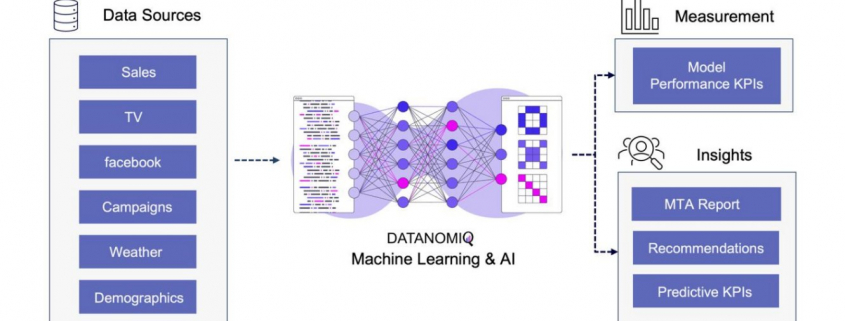 DATANOMIQ
DATANOMIQ









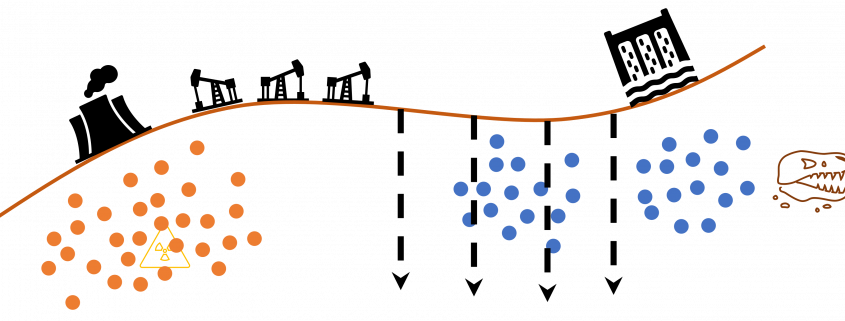



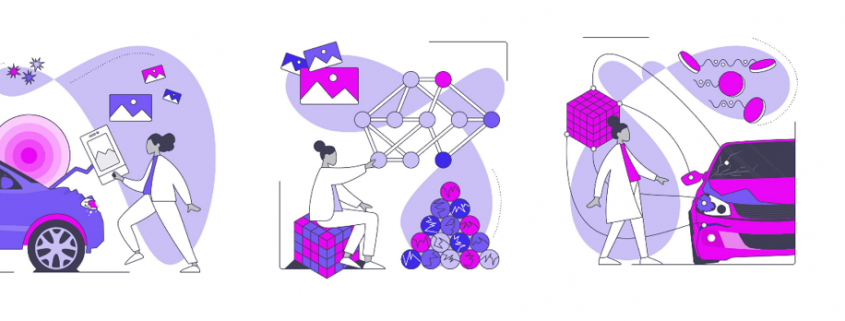 DATANOMIQ
DATANOMIQ

